Enjoy the beautiful and unique scenery of Kurobe Gorge (黒部峡谷) on the fun and exciting Torokko Train. You don’t want to miss this special natural wonder in Japan!
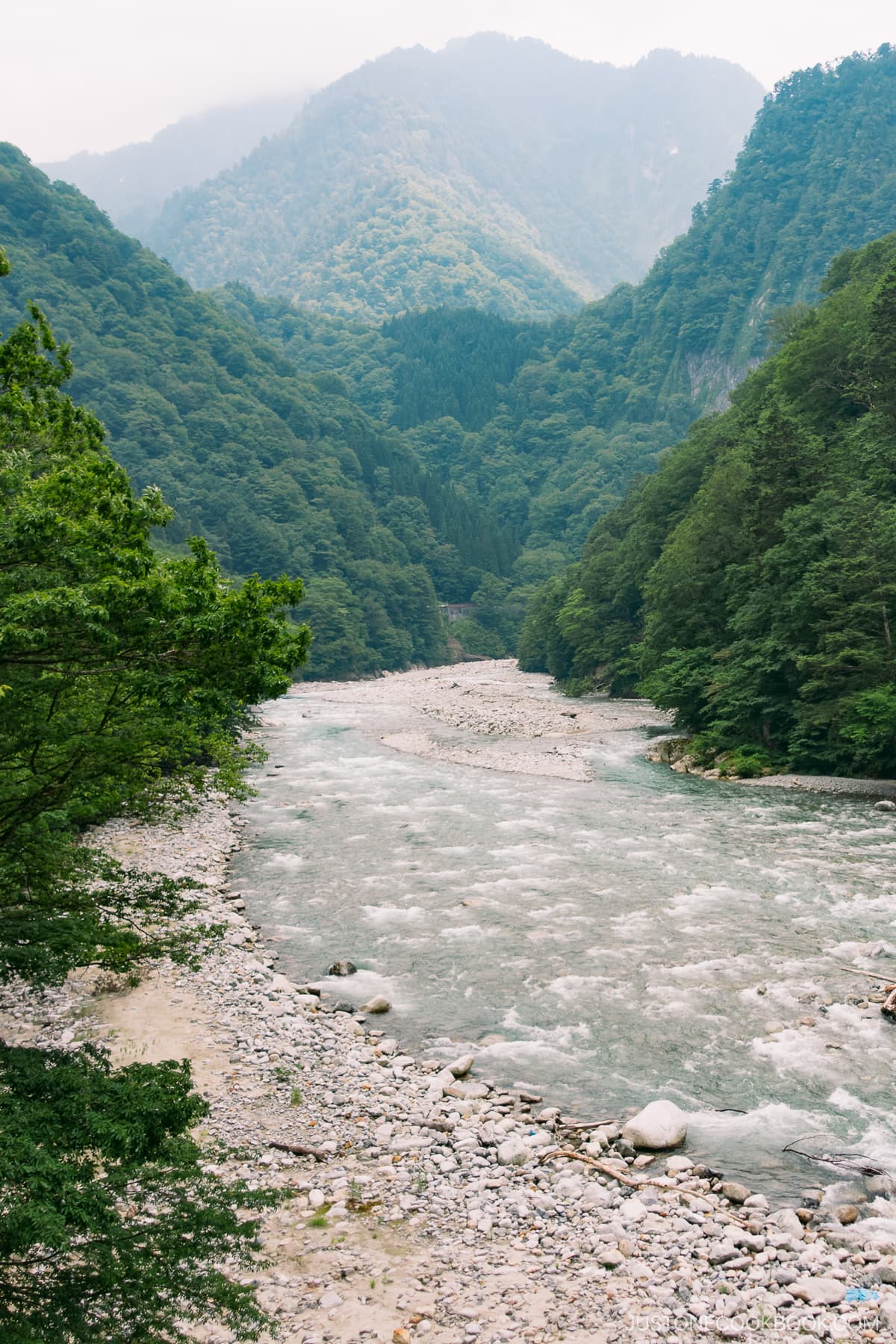
After visiting the beautiful historic city of Kanazawa and one of Japan’s three great gardens, the next chapter of our journey took us to another of Japan’s magnificent wonders: Kurobe Gorge (黒部渓谷). This natural wonderland is a treasure trove of awe-inspiring vistas and captivating landscapes. For those traveling with young ones, the Torokko train (トロッコ電車) promises an adventure that will leave them enthralled.
Where is Kurobe Gorge
Kurobe Gorge is located east of Toyama in the mountains near Mt. Tate. The best way to get there is via Shinkansen to Kurobe-Unazukionsen Station. Then walk over to nearby Shin Kurobe Station (新黒部) and head to Unazuki Onsen (宇奈月温泉). From Kanazawa to Unazuki Onsen, the total travel time takes roughly one and a half hours.
While awaiting the arrival of our train at Shin Kurobe Station, we had the opportunity to explore the Torokko train displayed just outside the station, much to the delight of our children!
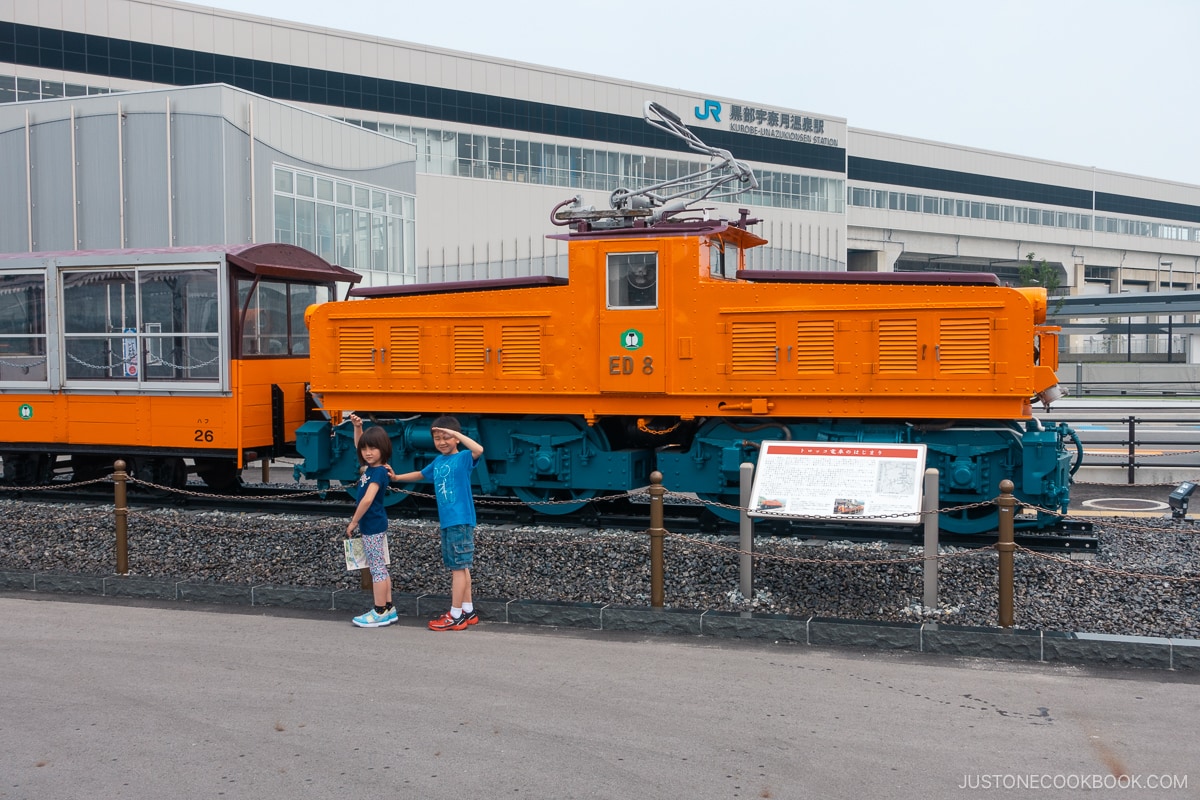
Shin Kurobe Station is nestled in a tranquil countryside locale, providing a peaceful backdrop to the picturesque rice fields as we await for the train’s arrival.
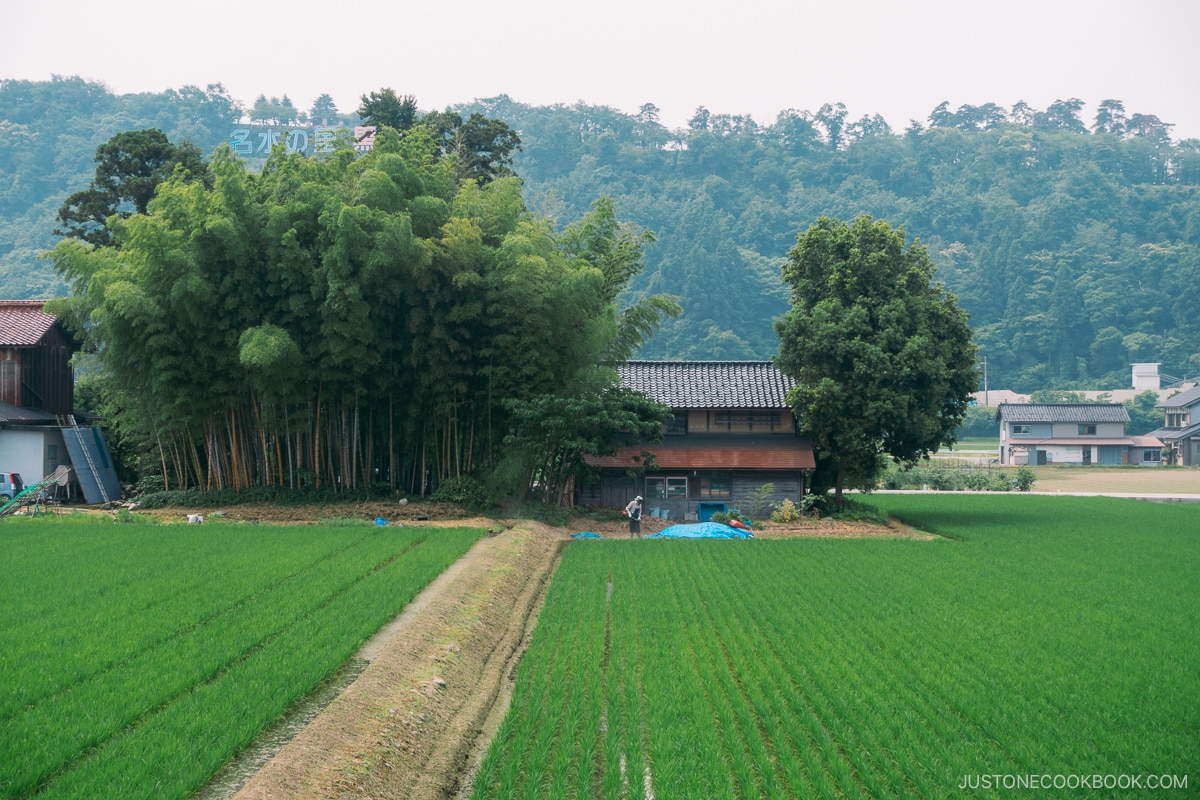
The ride to Unazuki Onsen station will take roughly 30 minutes. The trains on this route are older compared to the ones in Tokyo and other major cities.
Along the way to Unazuki Onsen, we passed by many small train stations and it was interesting for my family to see these older forgotten stations.
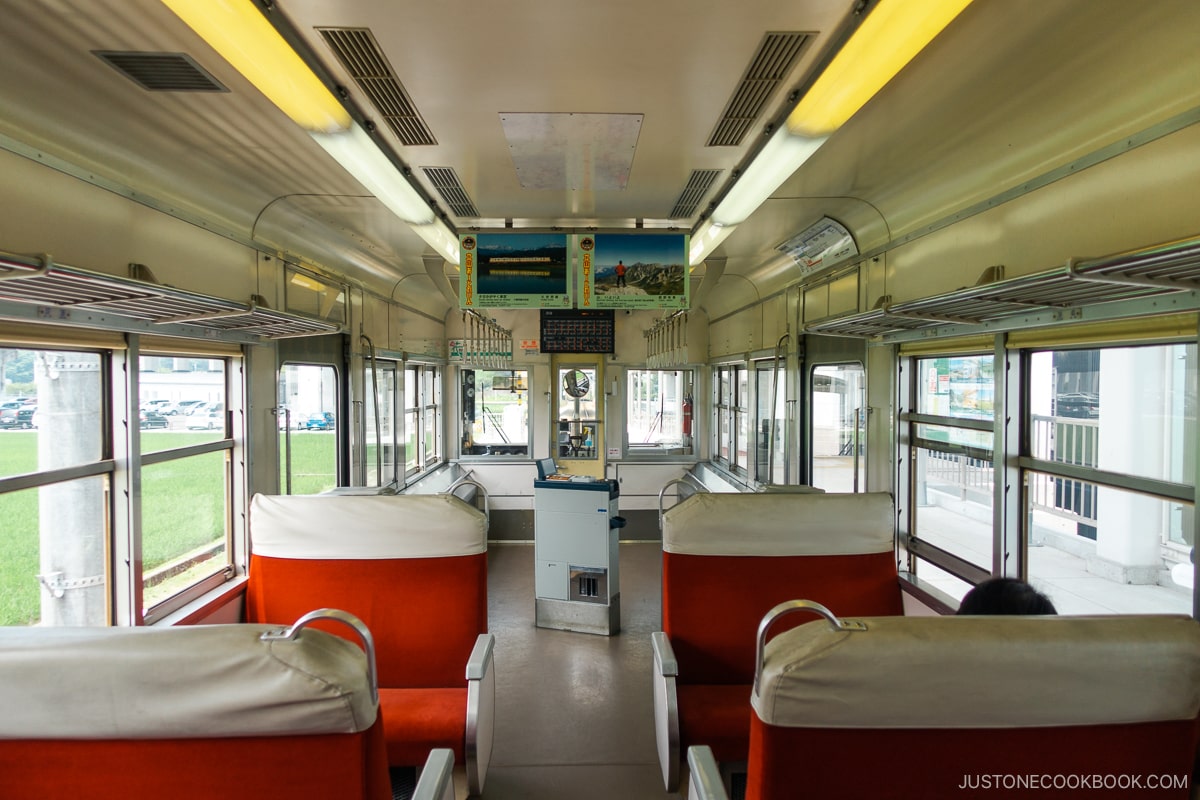
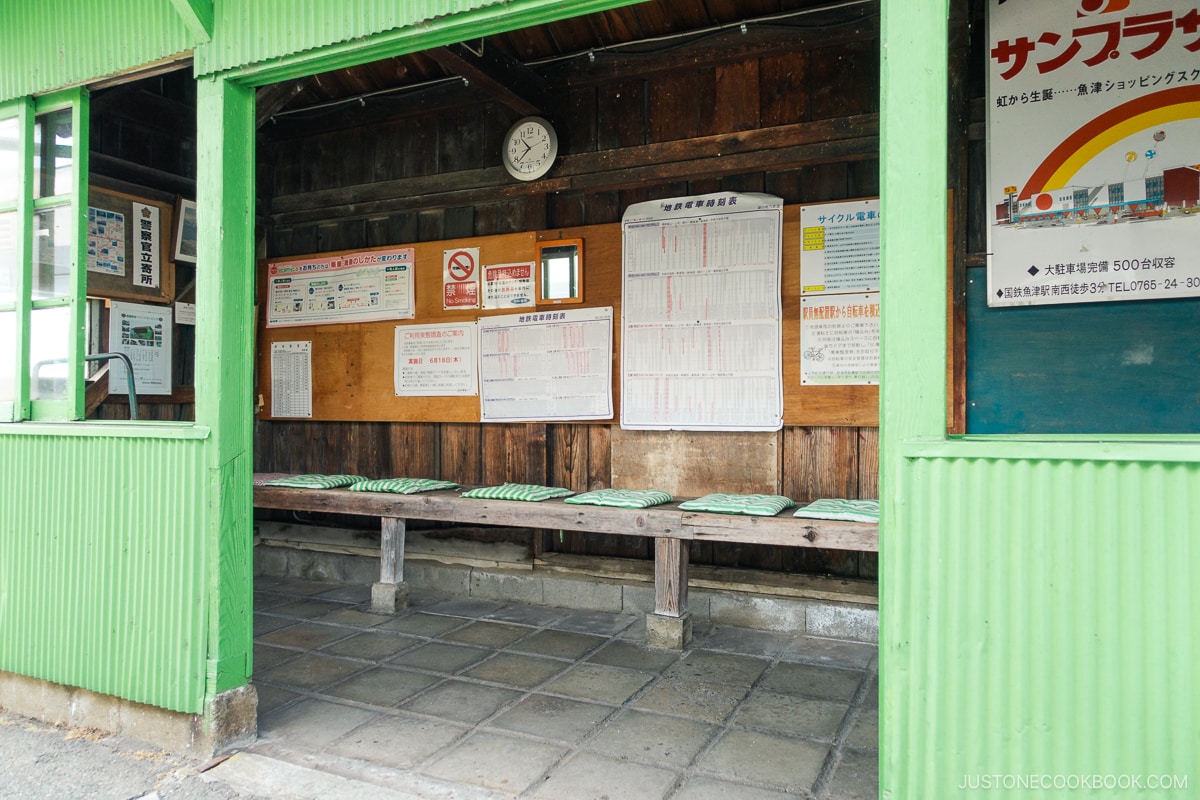
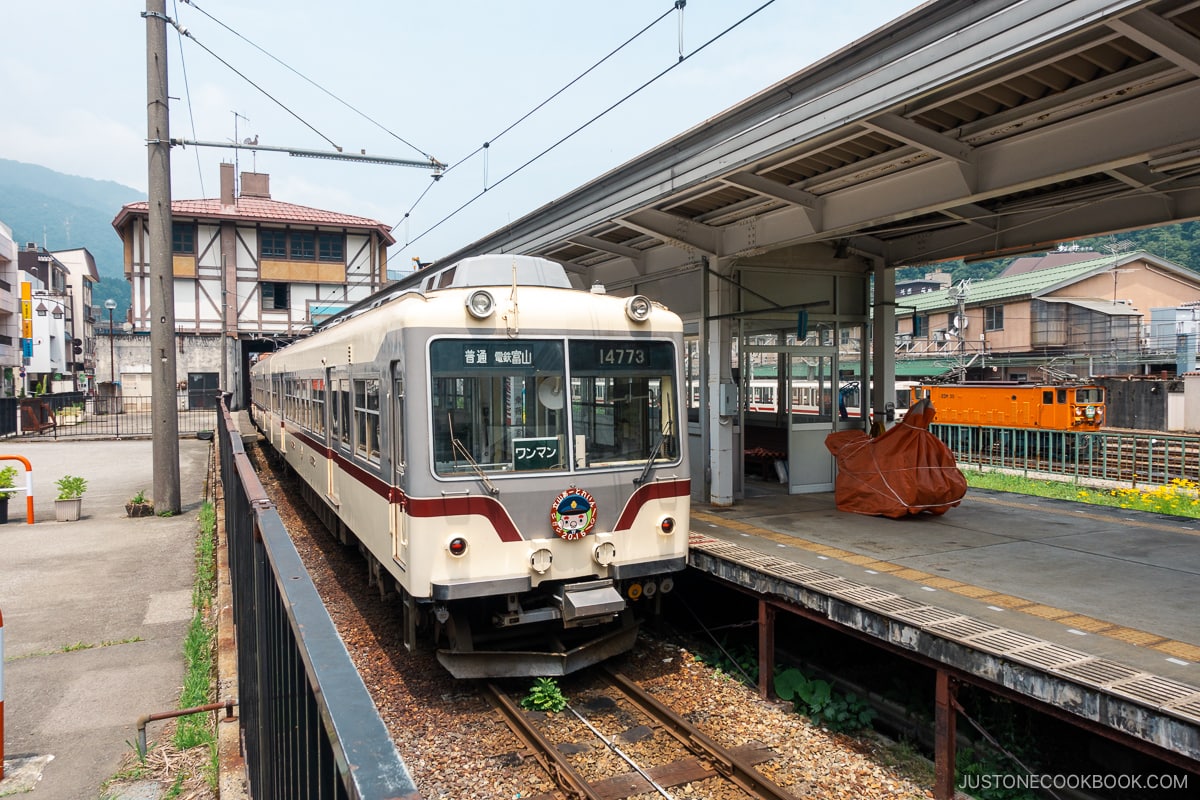
After arriving at Unazuki Onsen station, walk to Unazuki (宇奈月) station, where the Torokko trains will depart. I know the station names are similar and are a bit confusing so leave a comment below if you need any clarification.
Kurobe Gorge Torokko Train Experience
Are you familiar with the Torokko Train (トロッコ電車)? The Japanese term “Torokko” is derived from the English word “truck,” originally referring to mining or transportation cars used to transport materials for construction. These days, Torokko refers to passenger cars, designed with the bare minimum comfort and primarily used for sightseeing.
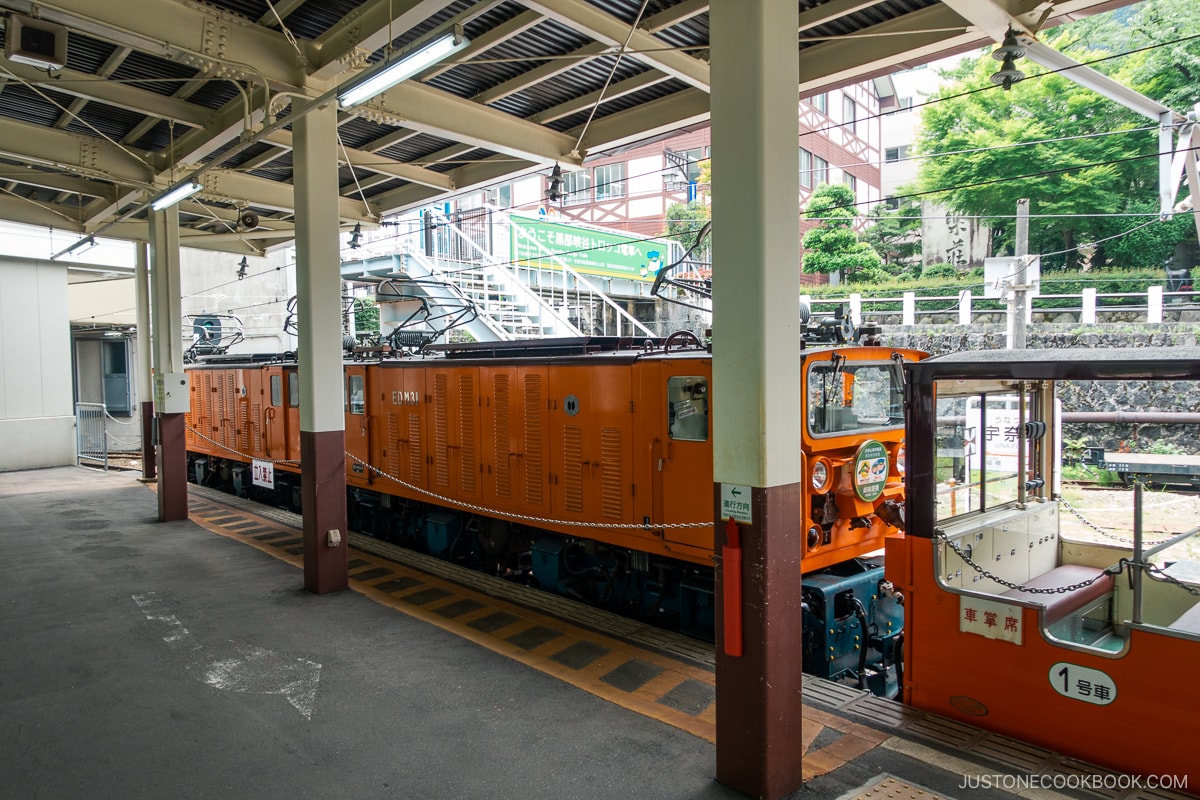
History of Kurobe Gorge Torokko Train
This incredibly scenic route of the Kurobe Gorge Torokko Train was originally built by the Kansai Electric Power company. The purpose was to transport materials and personnel for the construction of hydroelectric plants back in 1937. For a long time, it was just used by the company to maintain and build power plants. However, due to its unique landscape unlike anywhere else in Japan, there was a demand for people to see the sights themselves. As a result, the company started transporting passengers in 1953.
There are 2 types of seats available on the Kurobe Gorge Torokko train. The seats are either open-air or enclosed. The enclosed seats are referred to as first-class. You can check the ticket fares here.
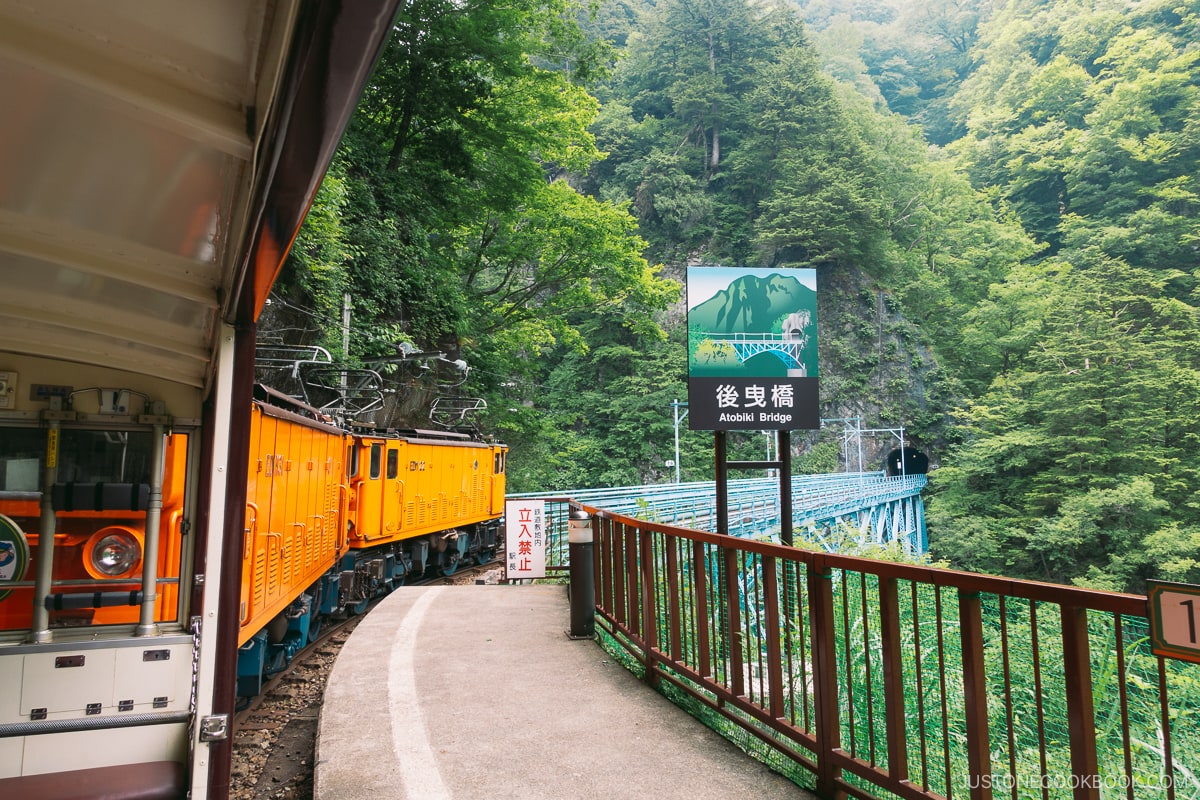
With the tickets, we were assigned to a specific car number but we could choose any seats within the car. The open-air cars have benches and the enclosed ones have individual seats. You can reserve and book the Torokko tickets online and the site also has multilingual services.
Stops On The Kurobe Gorge Railway
Along the Kurobe Gorge Railway (黒部峡谷鉄道) route, there are 3 stops where visitors can get off the train. They are Kuronagi (黒薙), Kanetsuri (鐘釣), and the final stop is Keyakidaira (欅平). However, please note that riders are not allowed to hop on and off the train between the start and final destination (see FAQs). After discussing the different options, we opted to go all the way to Keyakidaira. The ride to Keyakidaira takes 80 minutes each way.
We recommend sitting on the right side of the train for the best view. As the locomotive starts moving, we hear the rhythmic sound of the locomotive ahead of us and feel the vibrations and movements that are unique to the Torokko train experience.
Kurobe Gorge Railway Highlights
Soon after leaving the station, we saw the impressive, long and red Shin-Yamabiko Bridge (新山彦橋) and one of the many tunnels the train goes through.
The area is surrounded by pristine forest and undisturbed natural surroundings, with little evidence of humans being there (outside the power plants and the railroad). Thousands upon thousands of trees and greens as far as our eyes can see.
The first dam that we saw is Unazuki Dam (宇奈月ダム), which was completed in 2001. The view of the expansive emerald-green waters against the blue sky was gorgeous.
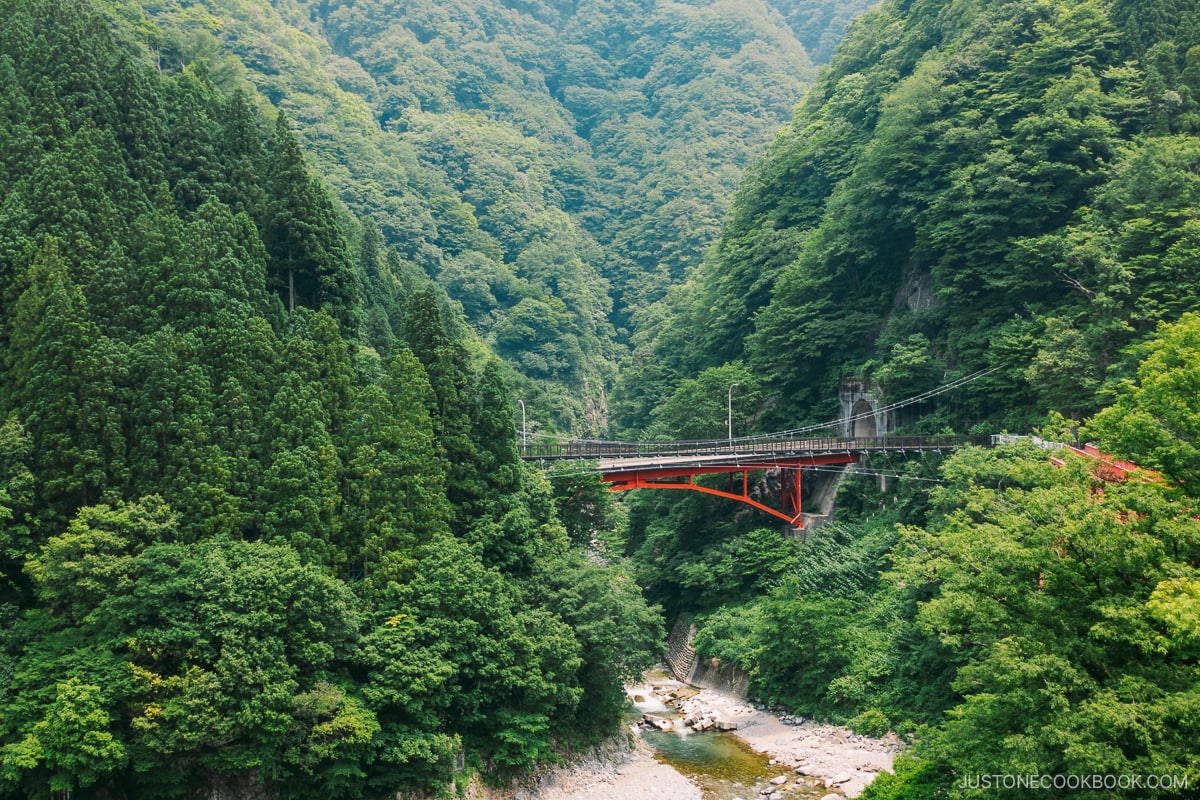
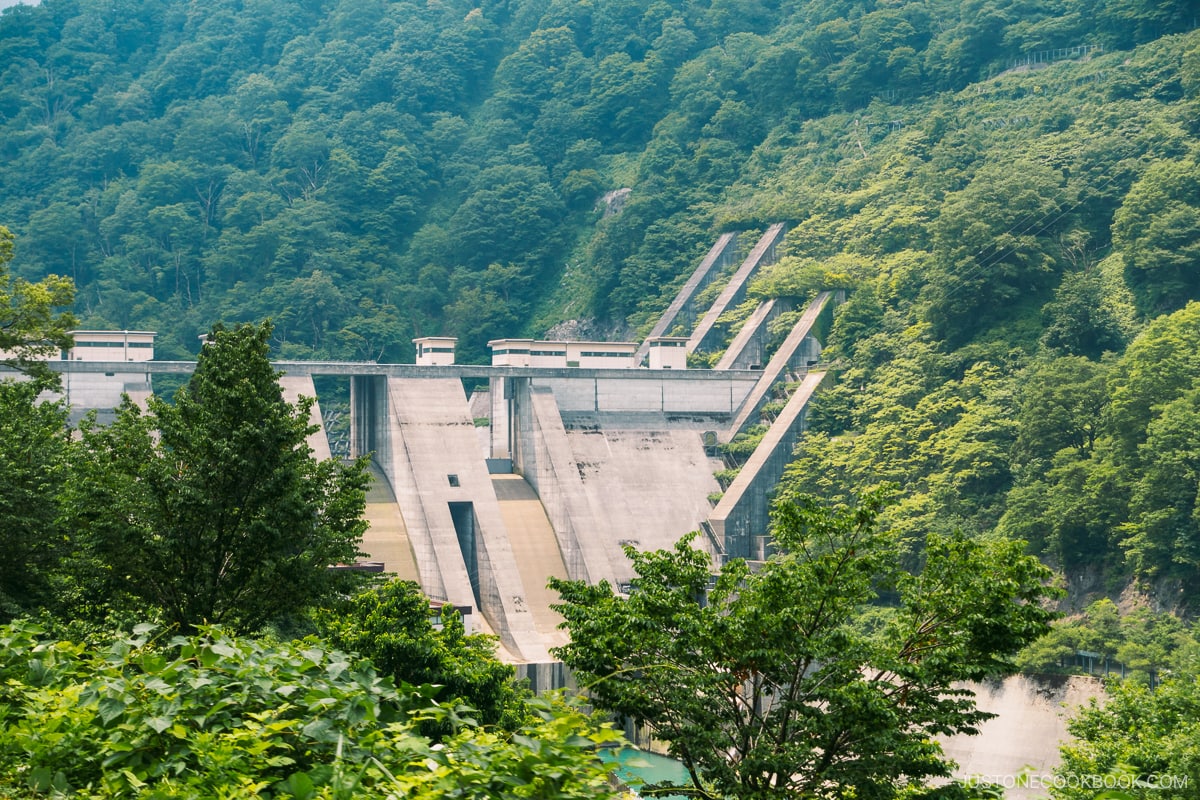
As the train proceeded along the route, we spotted the Shin-Yanagawara Power Station (新柳河原発電所) which resembles a European castle. It may seem like an unconventional design for a power plant but it’s one of a kind.
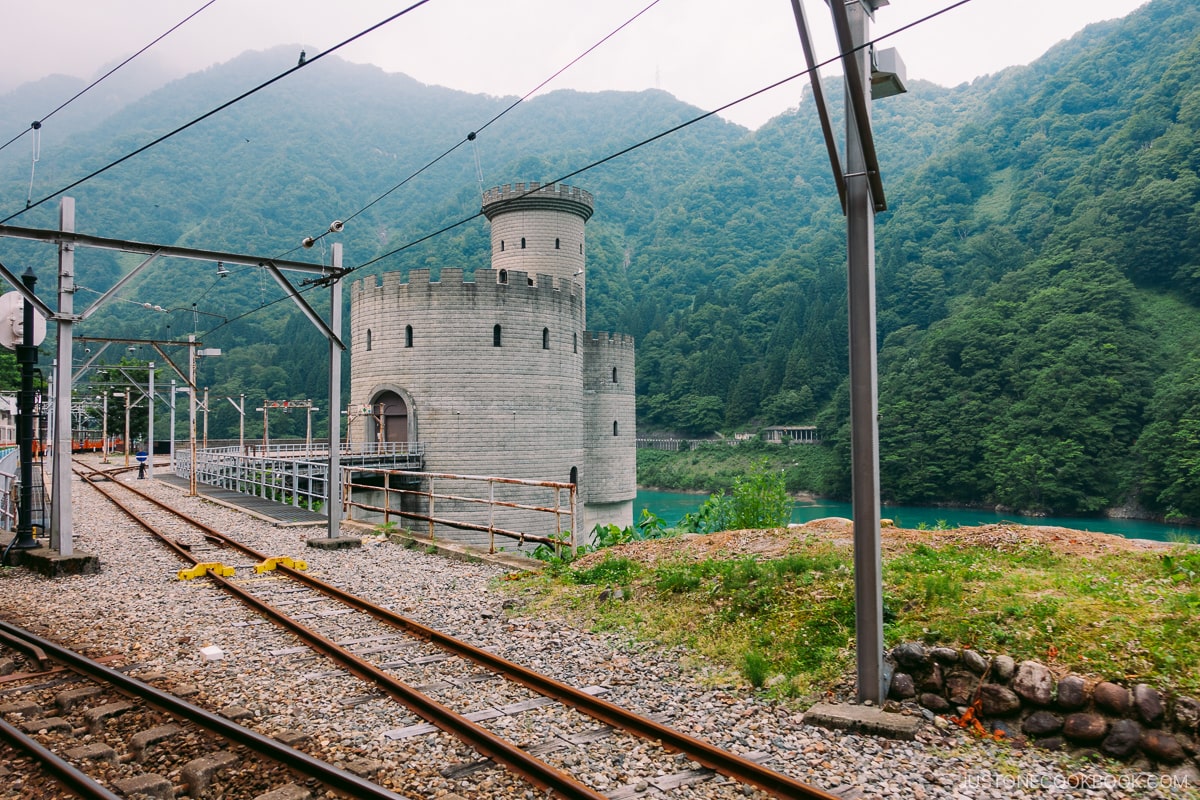
Kurobe Gorge Natural Beauty
At certain points during the journey, we couldn’t resist the thrill of adventure as the train traversed sections of the route supported by sturdy steel beams. It felt as if we were in an Indiana Jones movie.
The area’s natural setting is home to wild monkeys. There is even a suspension bridge built just for them to cross the gorge.
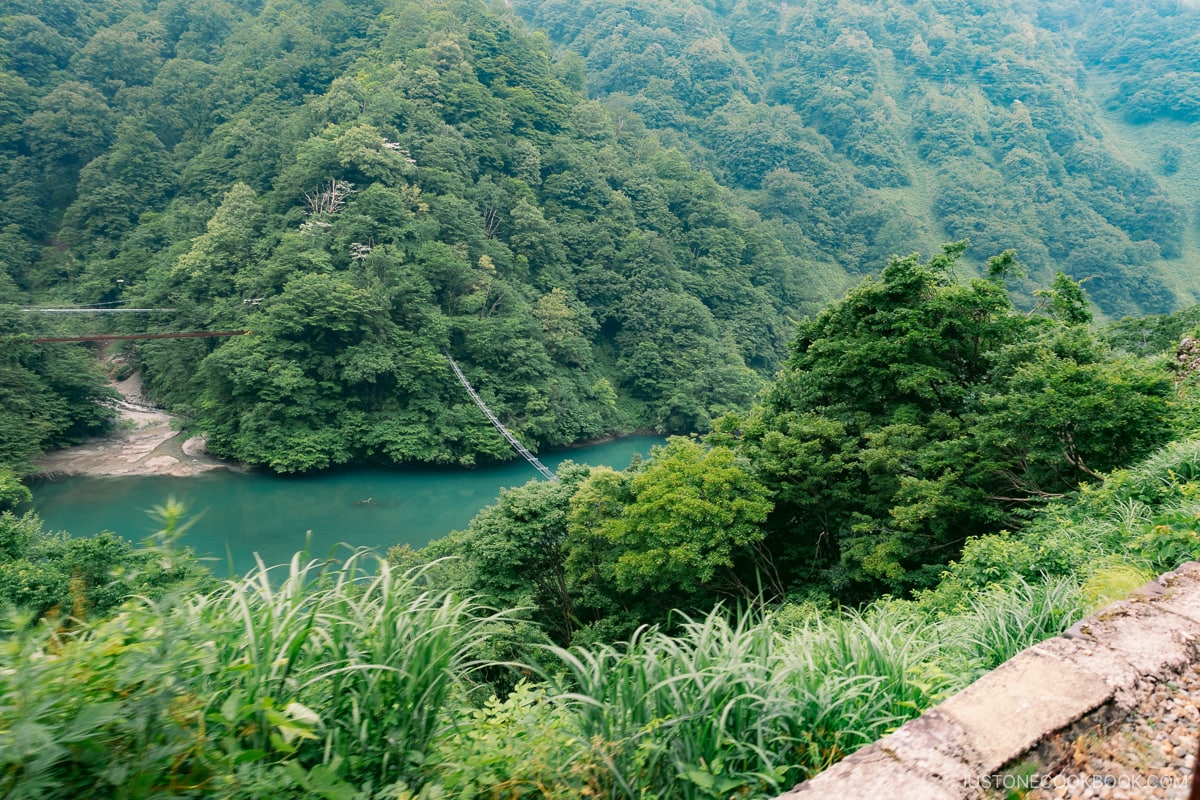
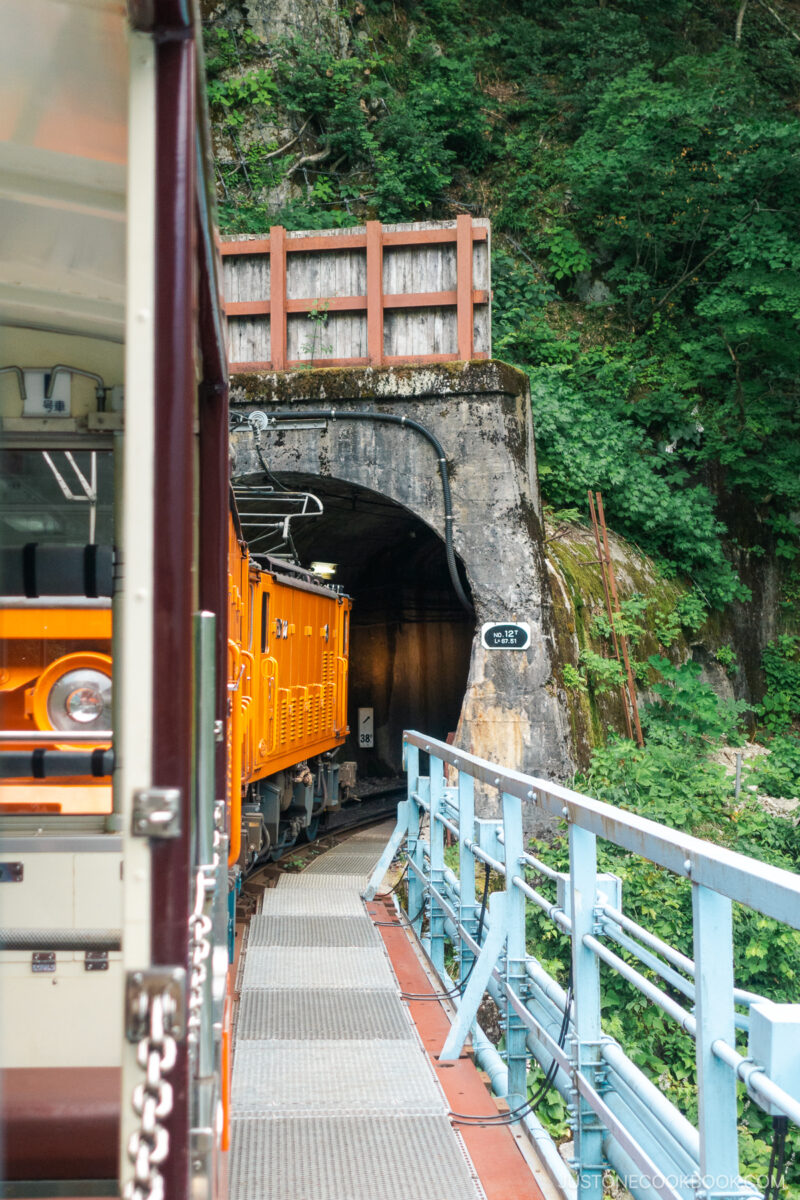
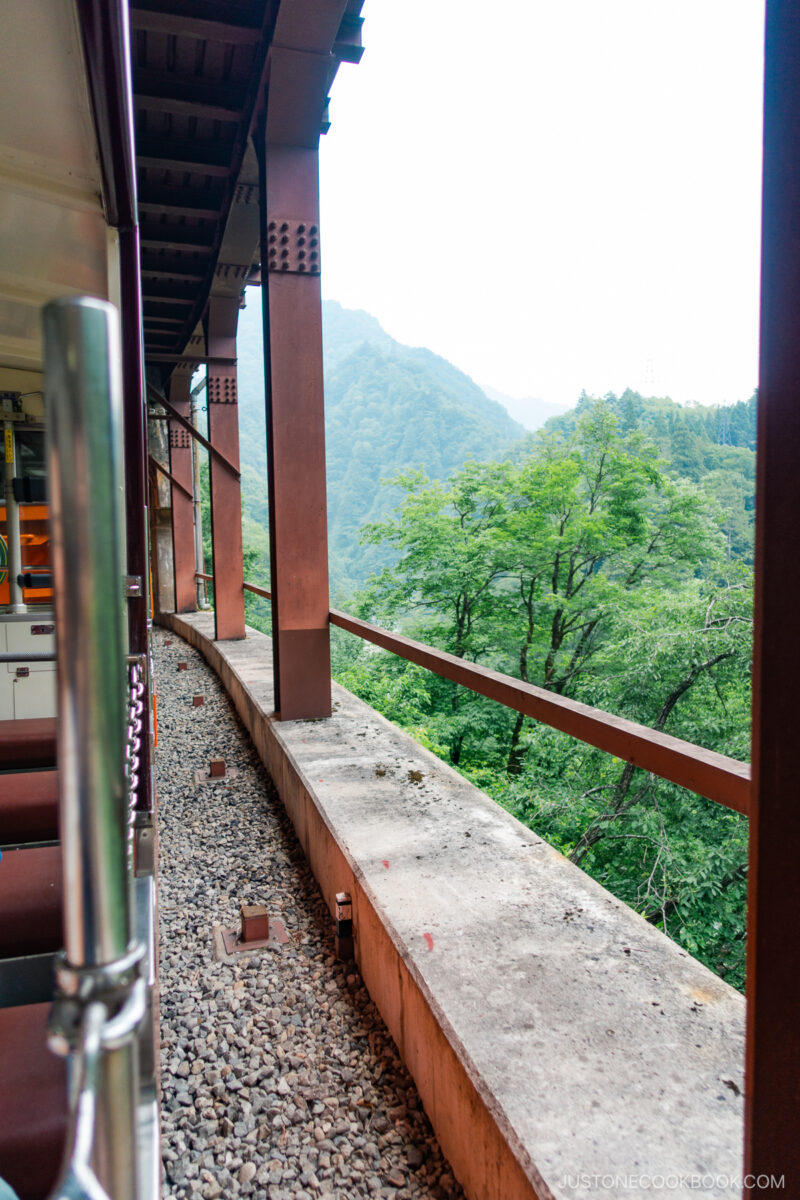
We thought about the immense challenges faced by the workers who constructed this passage. Throughout most of the route, the train tracks clung precariously to the mountainside, with sheer cliffs on the other side.
Crossing the Atobiki Bridge (後曳橋) was both terrifying and exhilarating, as we peered down below. I have to admit: the thought of what might transpire in the event of an earthquake crossed our thoughts at that moment.
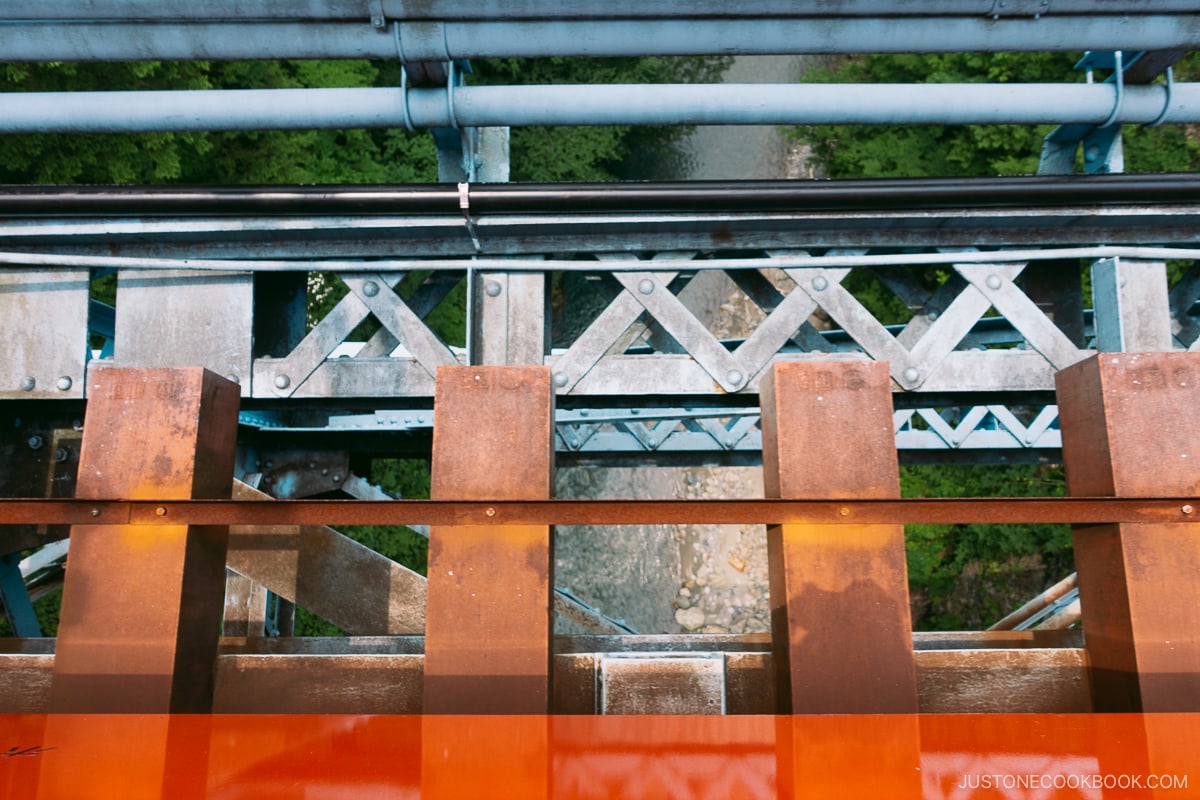
After passing Kuronagi station, near the Atobiki Bridge, we saw the aqueduct that carries water from Dashidaira Dam (出し平ダム) to Shin-Yanagawara Power Station.
The bridge connects one of the many V-shaped ravines in the gorge.
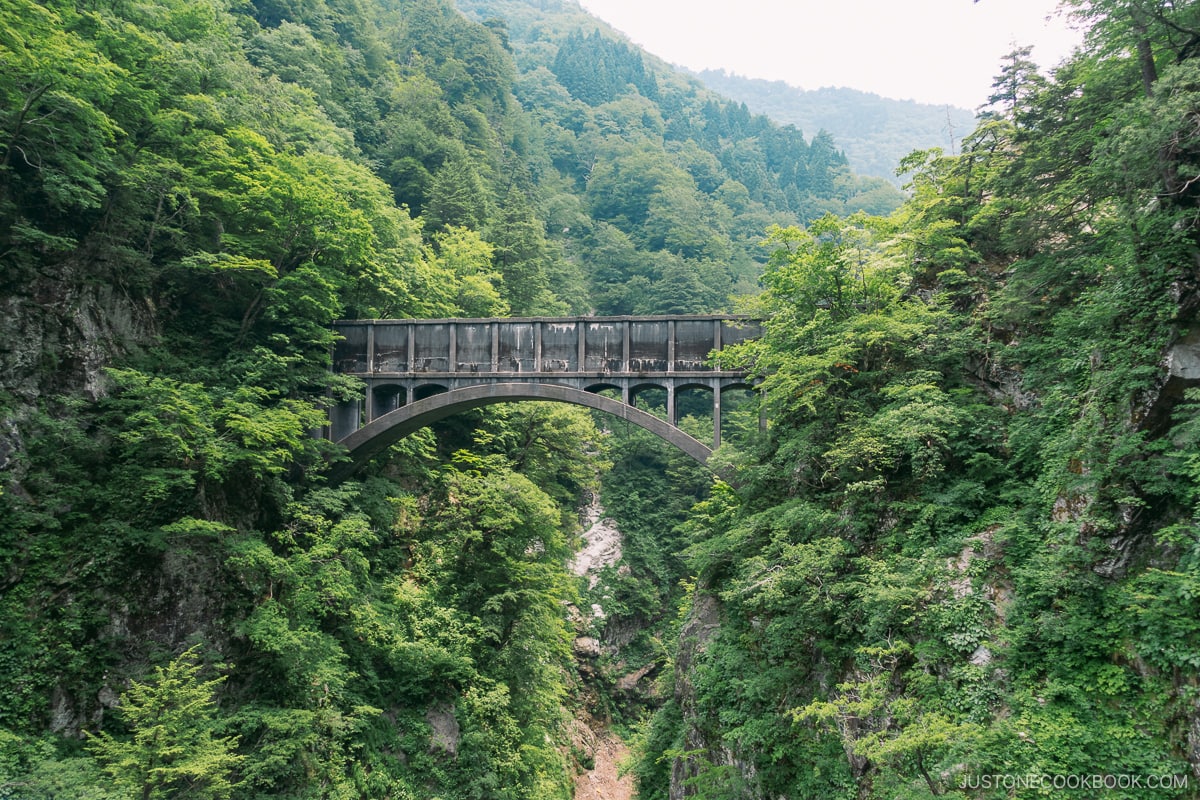
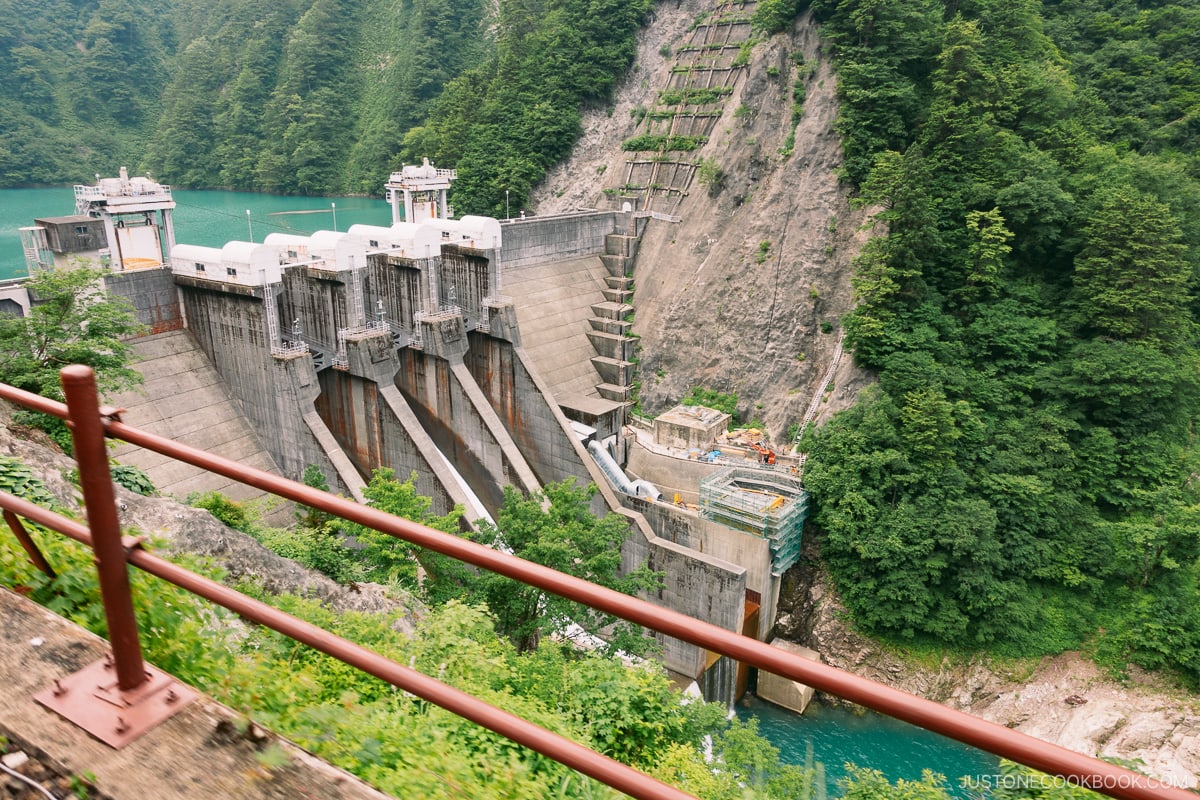
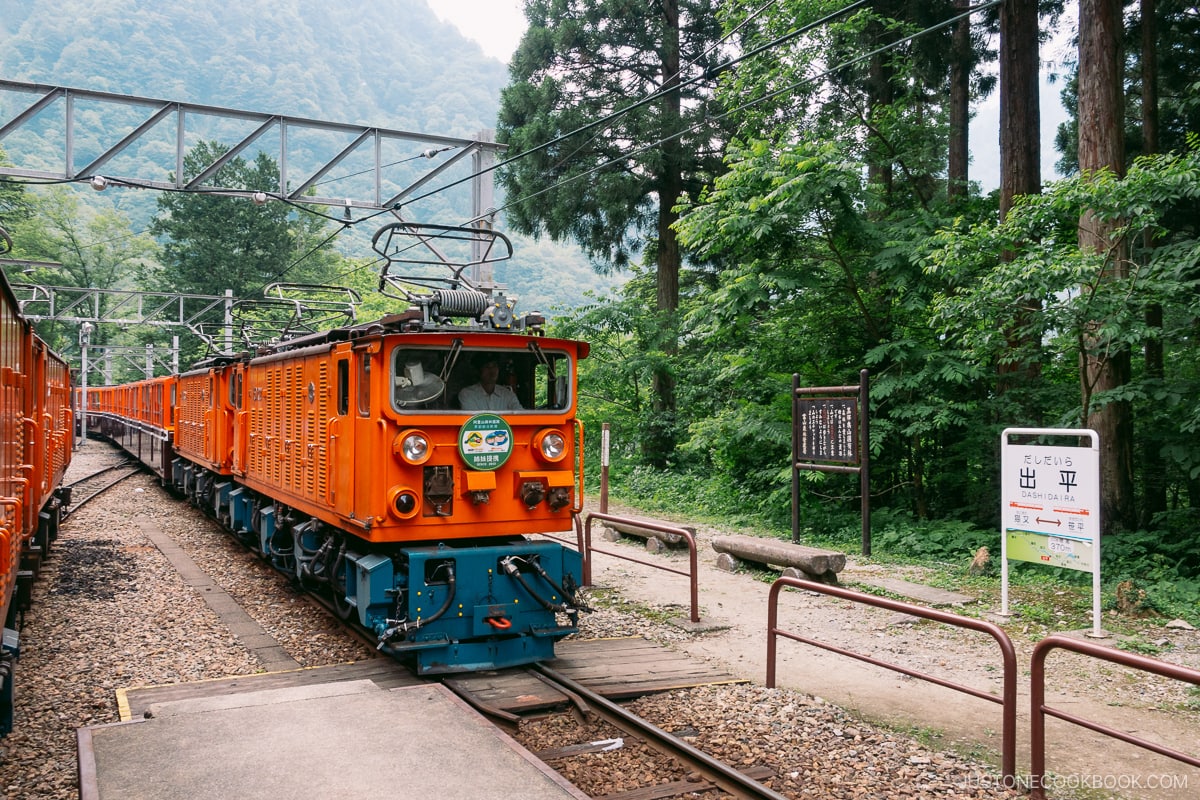
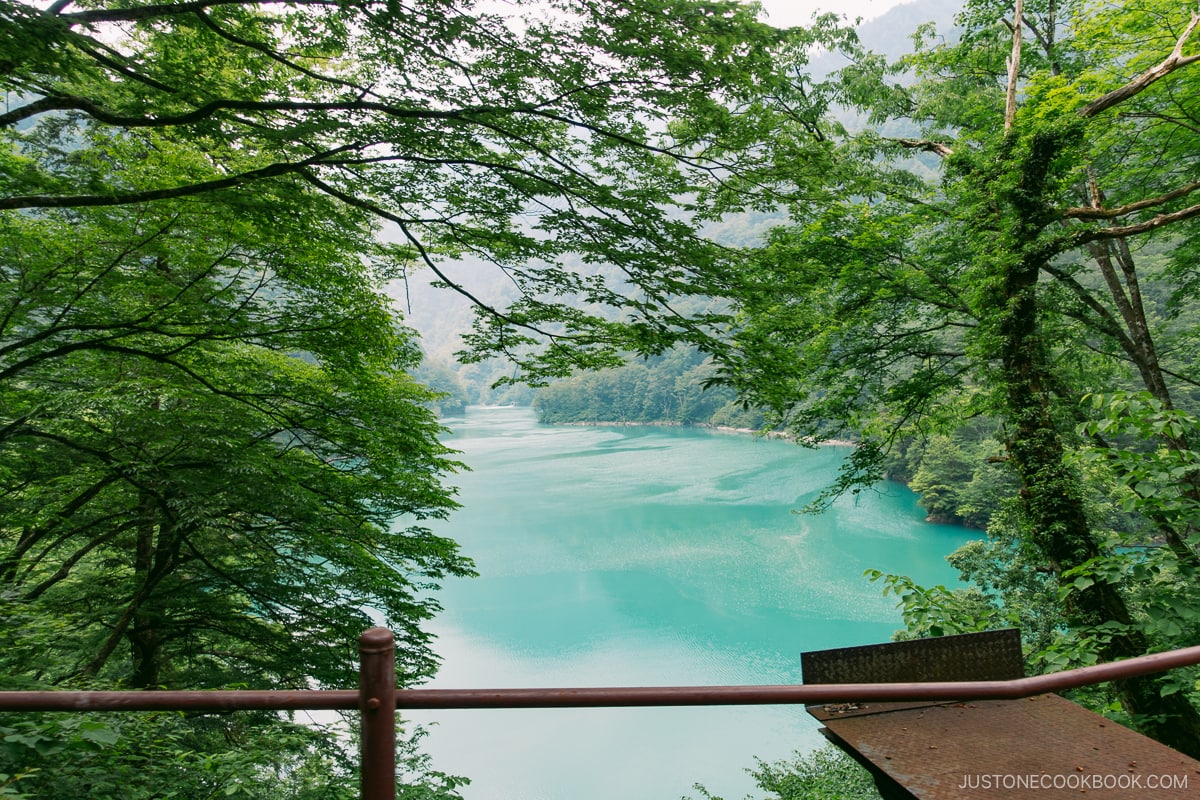
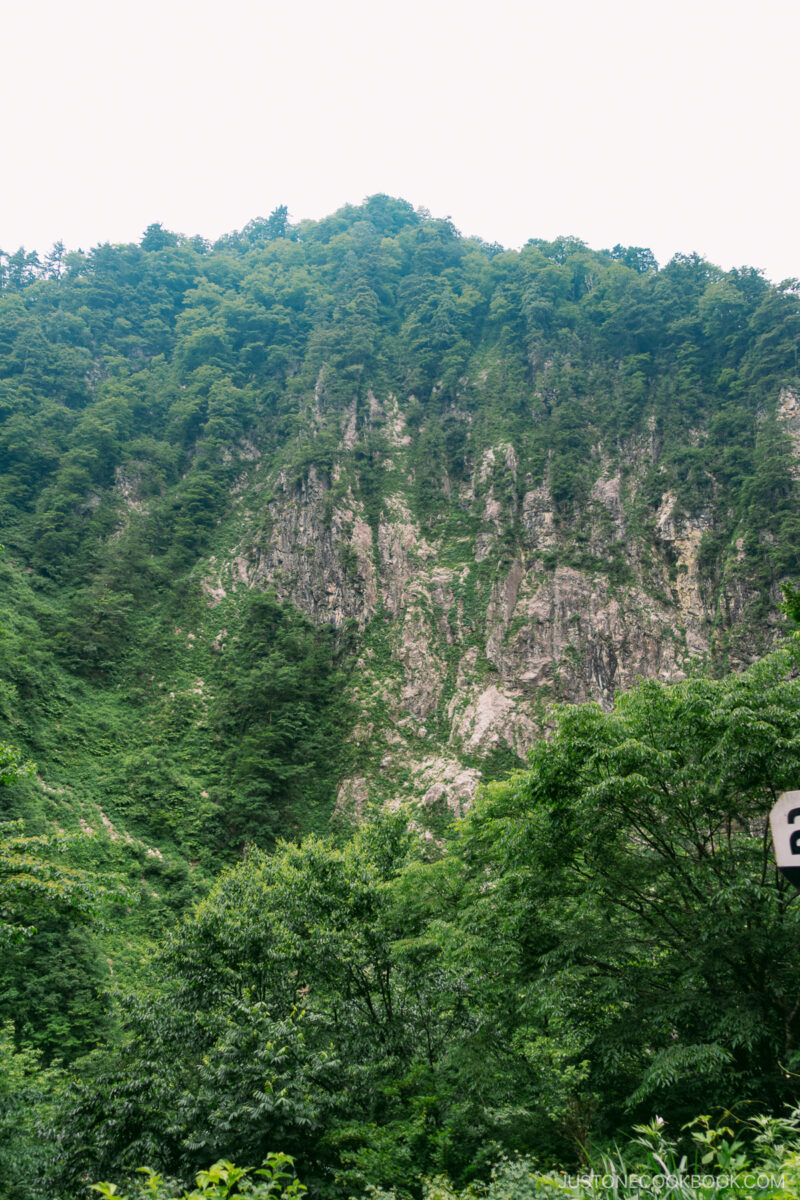
Kurobe Gorge Rock Formation
Due to heavy snowfall in the region, the Kurobe Gorge Torokko Train operates from April through November. You might wonder, how do the electric company workers maintain the power stations in the winter? Well, there is a winter walking path tunnel they have to use (see below) to hike in!
One of the most impressive sights along the route was the vertical 200-meter-high cliffs of the gorge. It is known as “Nemikaeshi no Iwakabe”(ねみ返しの岩壁), which was formed by the Kurobe River.
There is only one track so when there’s a train coming from the opposite direction, both trains have to stop and wait as they change tracks at the stations.

Another power station we saw on the route is the Kurobe River No. 2 Power Station (黒部川第二発電所). It was interesting to see how these industrial power stations blended into the natural surroundings.
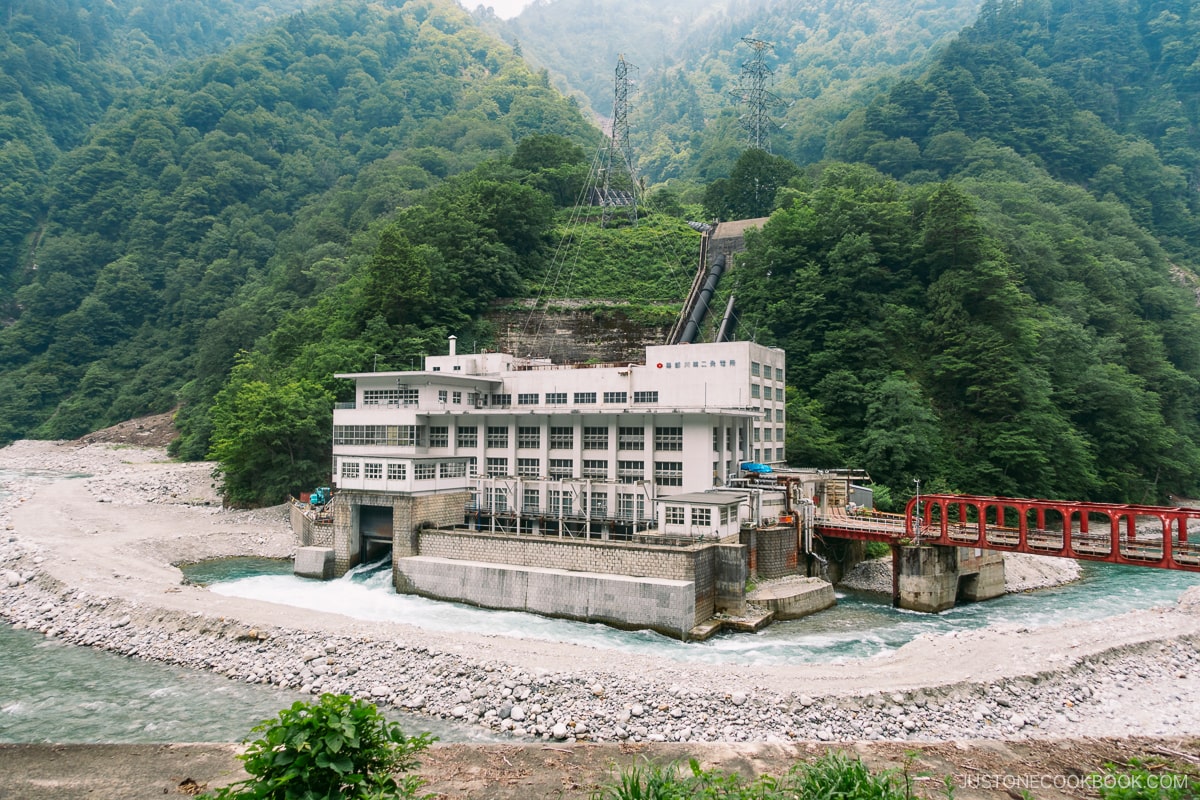
At Kanetsuri station, the second stop along the way where tourists can disembark, we saw the fascinating phenomenon of the “never melting snow” (mannenyuki 万年雪) near the station. This snow pile is created by avalanches during the winter and there is so much snow that it will not melt before the snowing season starts again.
As the train journeyed on, we soon passed Koyadaira Dam (小屋平ダム).
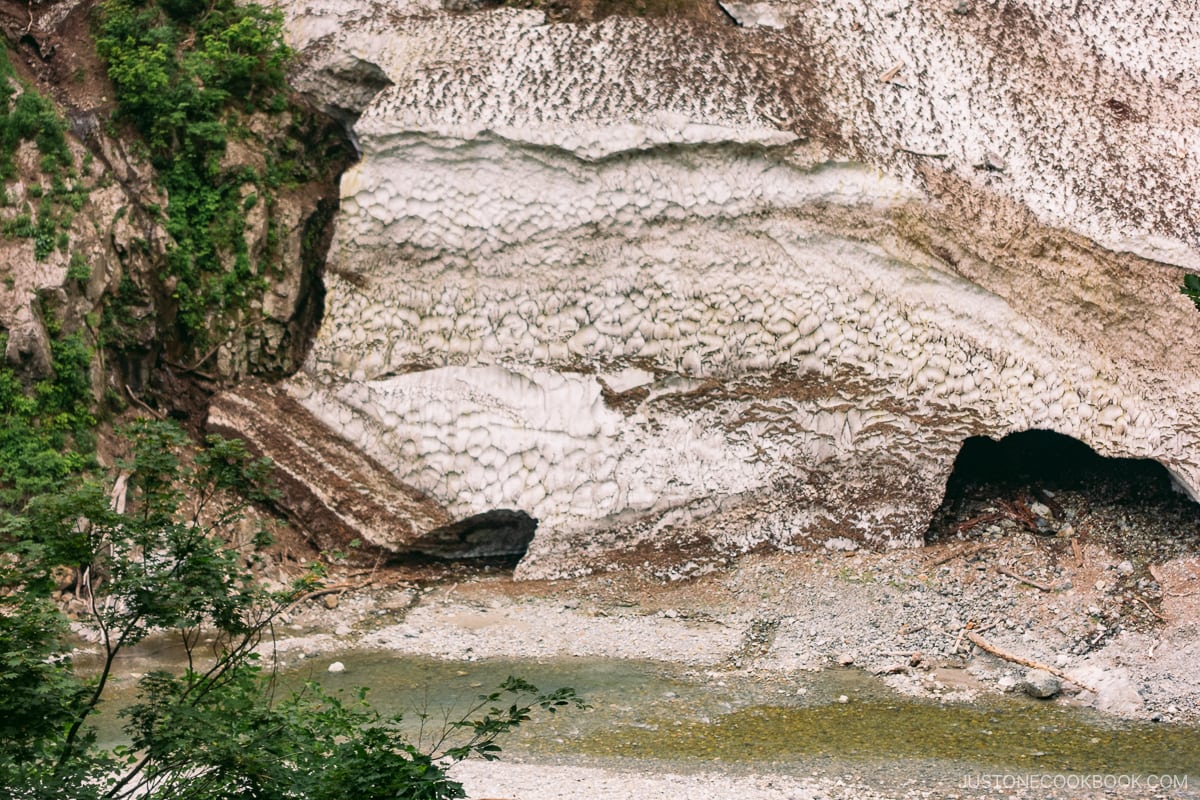
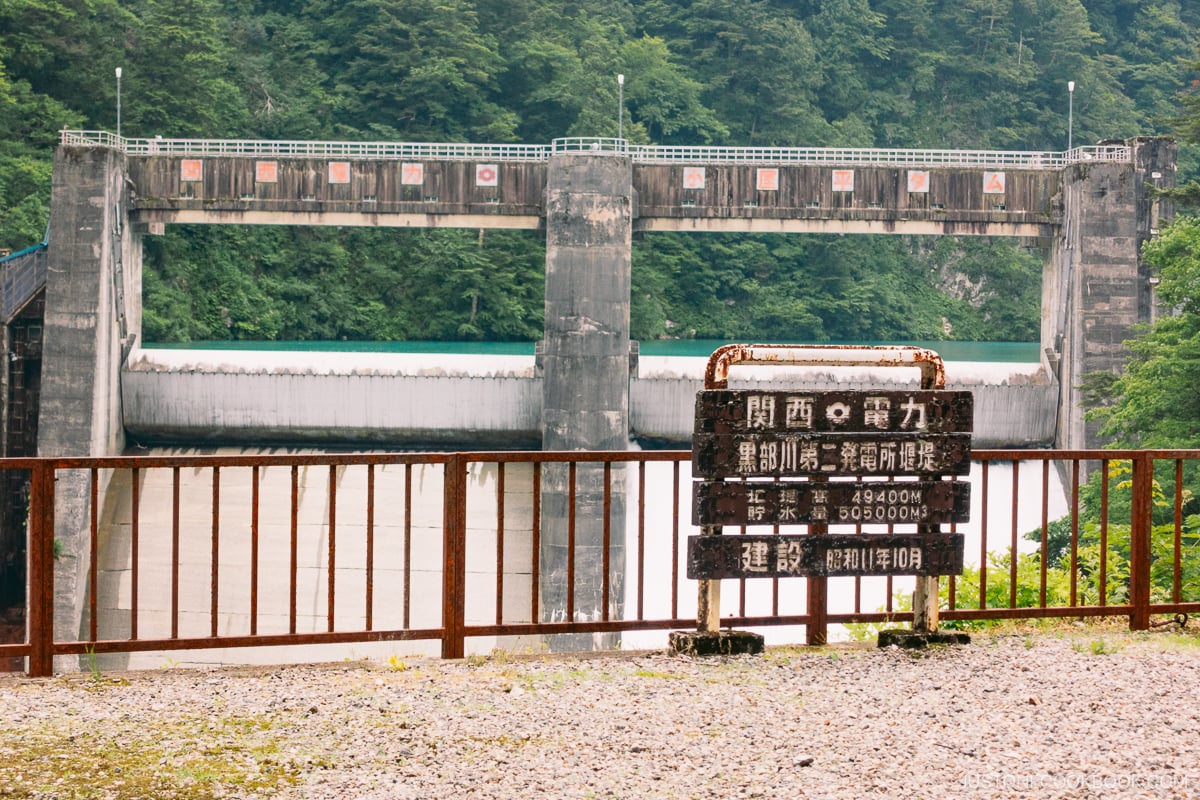
Even though the color was not the most vivid for the gorge during the summer, we loved the different shades of green. We would love to go again in autumn when the leaves change color.
Be Prepared For Temperature Change
The ride started in fairly comfortable weather; however, as we went deeper and deeper into the gorge, it turned chilly when we cruised through the tunnels. Each tunnel felt a bit colder than the last one. We did research beforehand and brought jackets with us to stay warm. Definitely bring extra jackets or long pants as some of the tunnels are quite long. It feels extra cold with the wind chill factor in the open cars even during the summer time.
Keyakidaira Kurobe Gorge
After arriving at the last stop, Keyakidaira Station, we recommend booking and reserving the ticket back to Unazuki Station at the ticket booth. We upgraded our tickets from the standard car to the enclosed car on the way back.
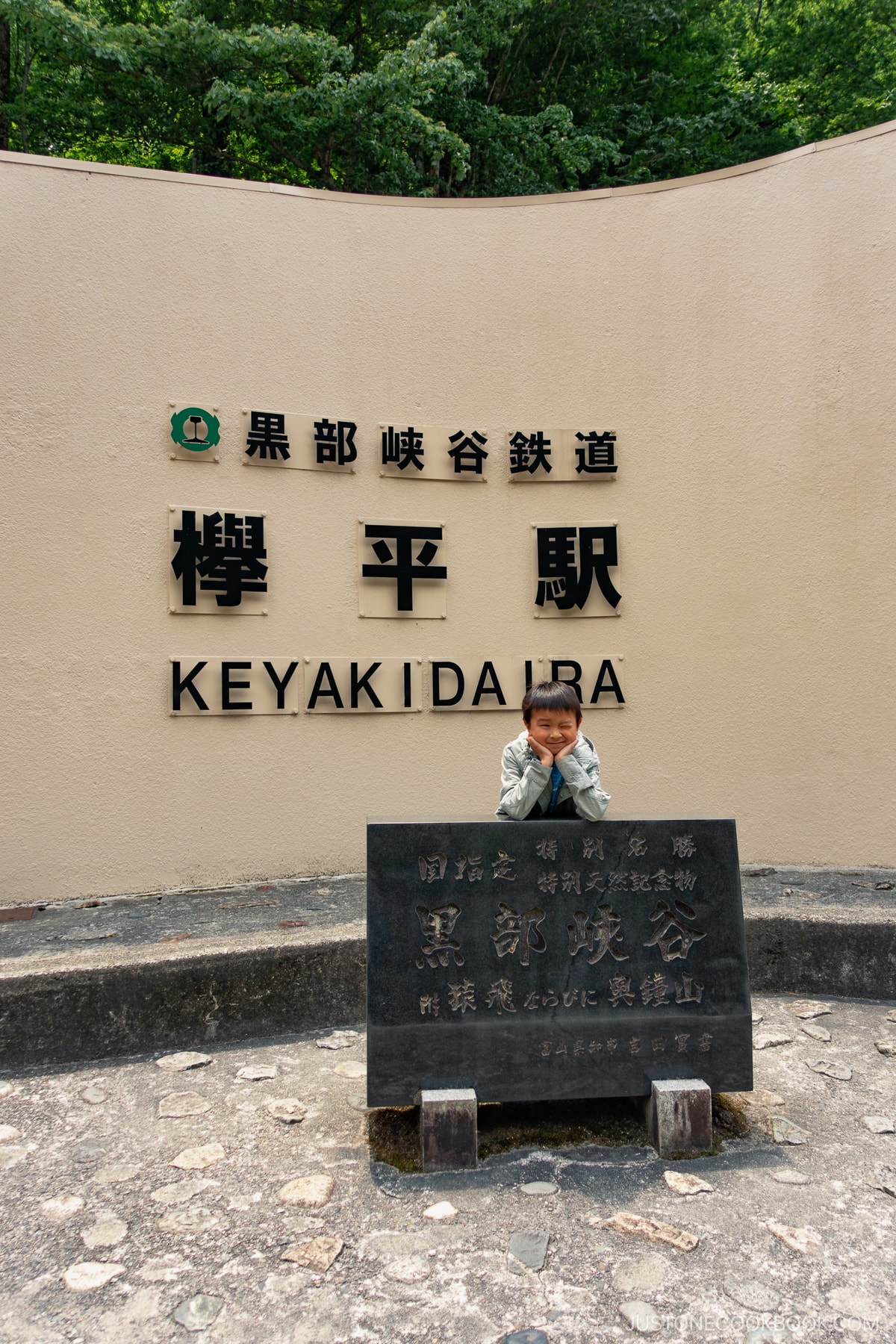
We reached the Keyakidaira station just around lunchtime and discovered there were few dining options available so we opted for the restaurant above the station.
It offered standard Japanese comfort food such as udon, soba, ramen, and curry rice. It also offered the local specialty Deep-fried White Shrimp (白海老のかき揚げ) over rice, udon, or soba.
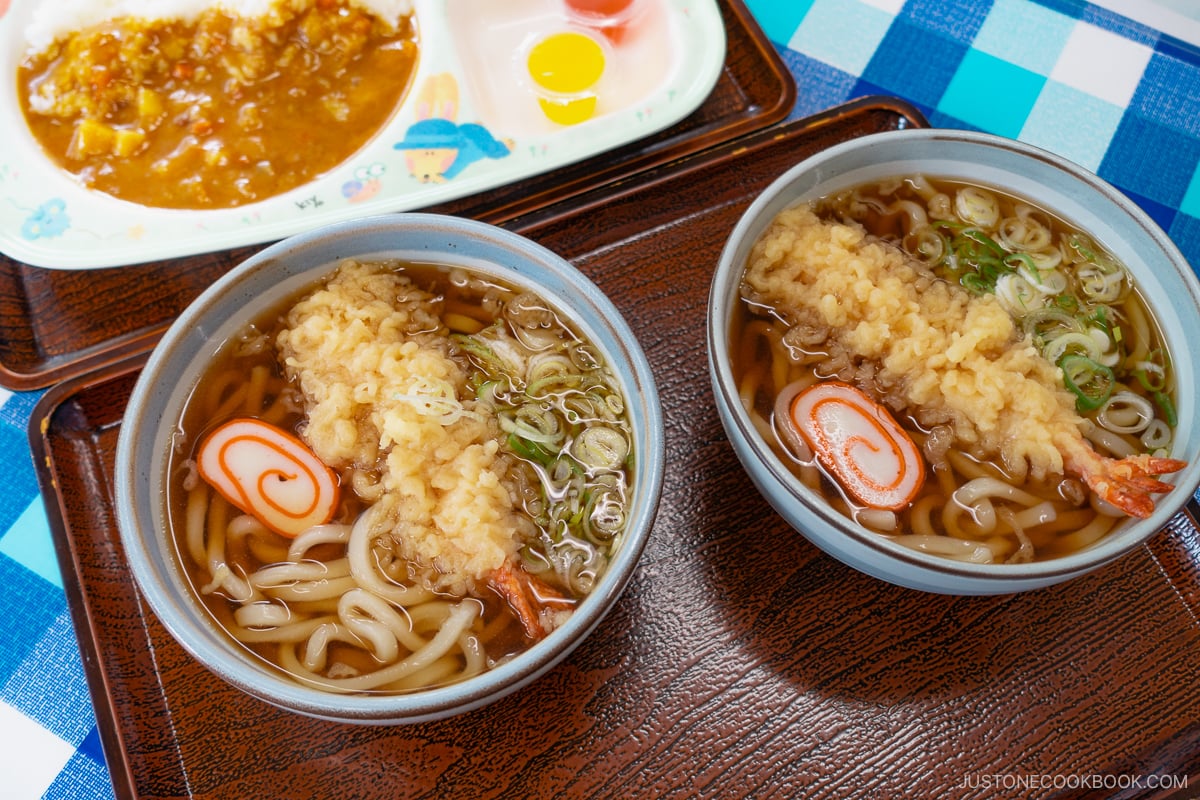
Considering how remote the restaurant was, our tempura shrimp udon was pretty decent. Our kids particularly enjoyed the kids’ curry menu.
At the station near the ticket booth, they had a large map of nearby points of interest and showed the approximate time it takes to walk to those locations from the Keyakidaira station. It also tells the visitors if specific spots were closed due to landslides.
Things to do at Keyakidaira station
It’s important to check for any closures first as the entire area is very prone to rockslides and landslides. Unfortunately, when we visited, the trail to both Sarutobikyo Gorge (猿飛峡) and Babadani Onsen (祖母谷温泉) was closed so we had very limited sights to see.
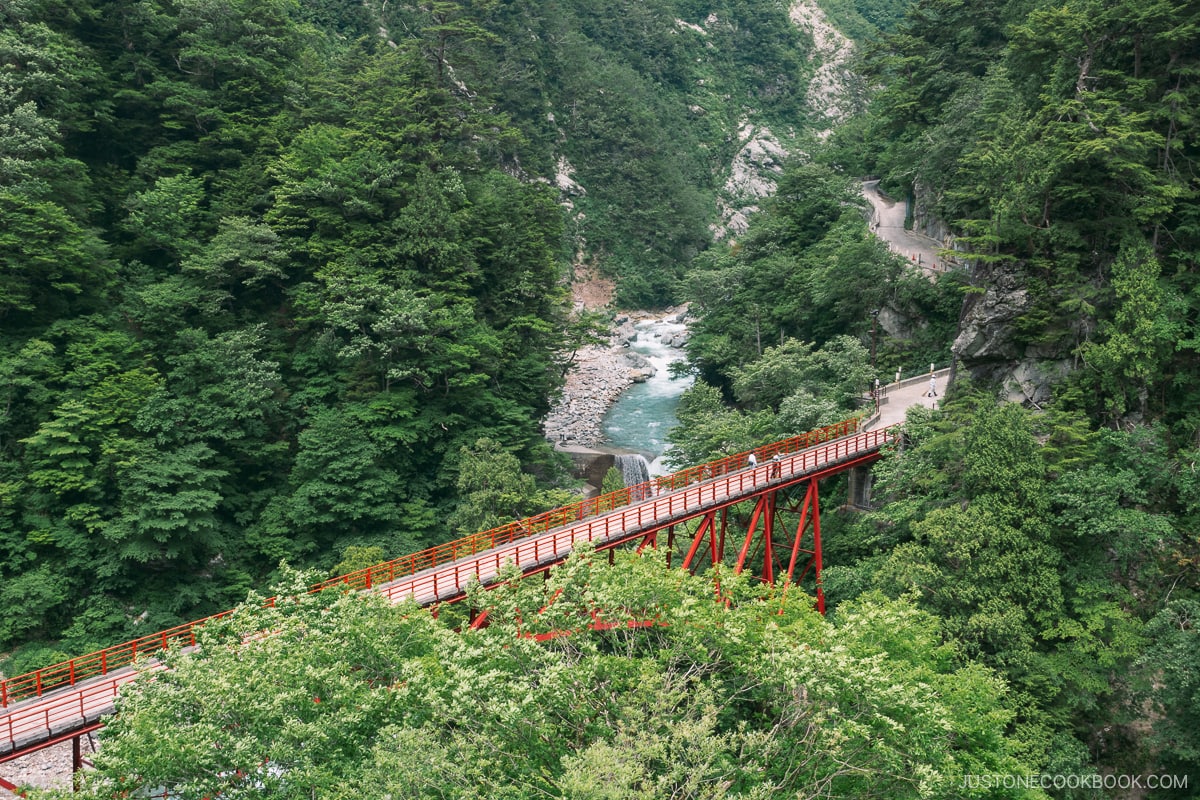
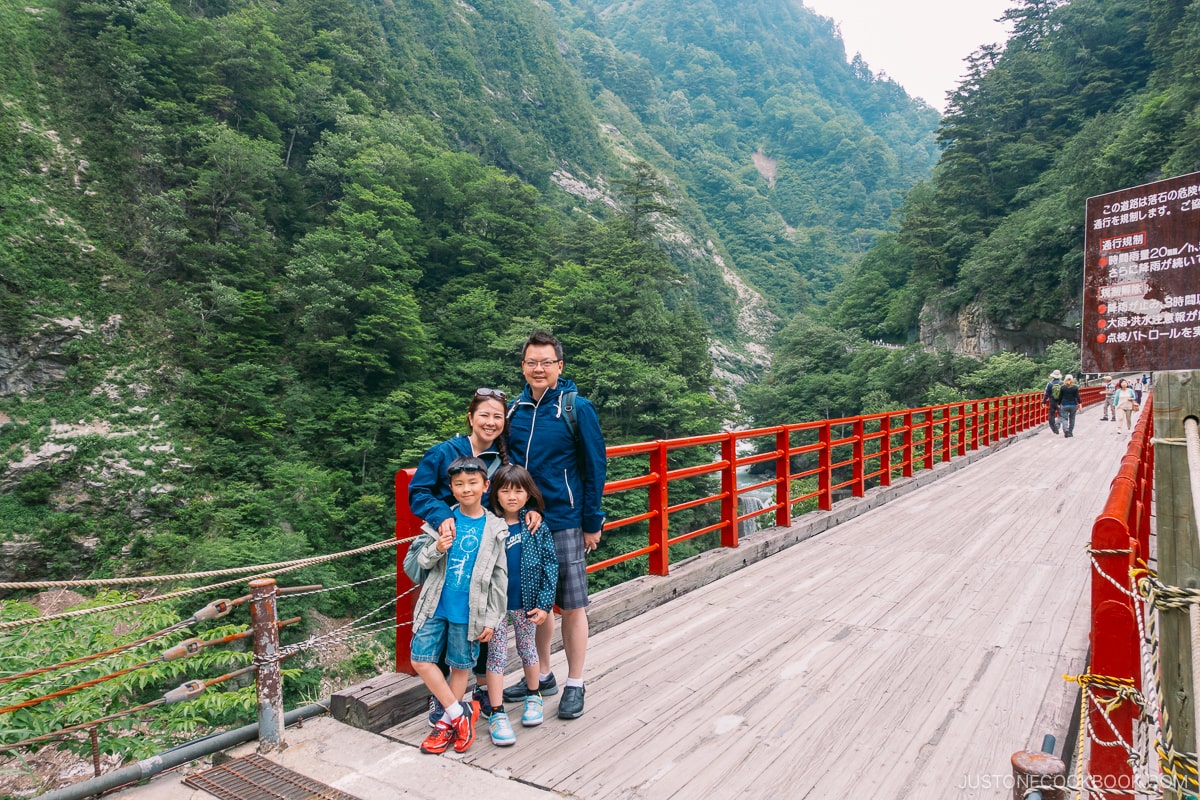
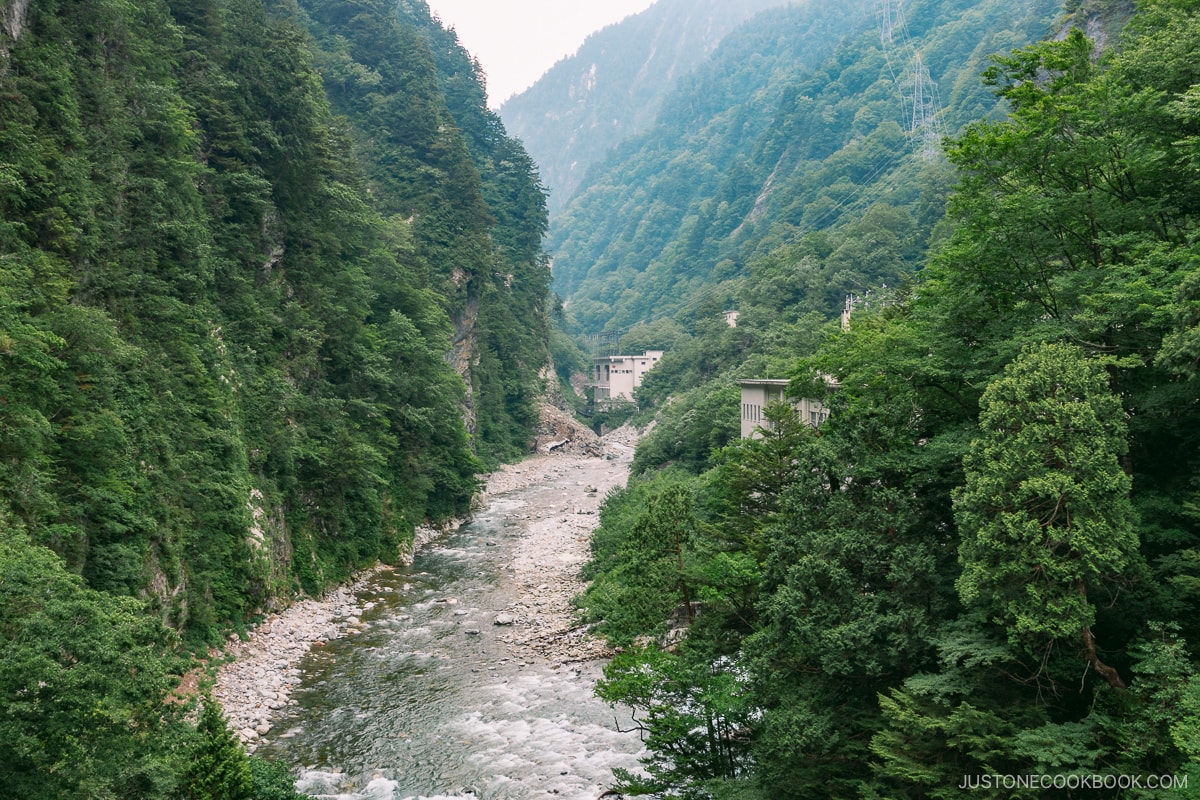
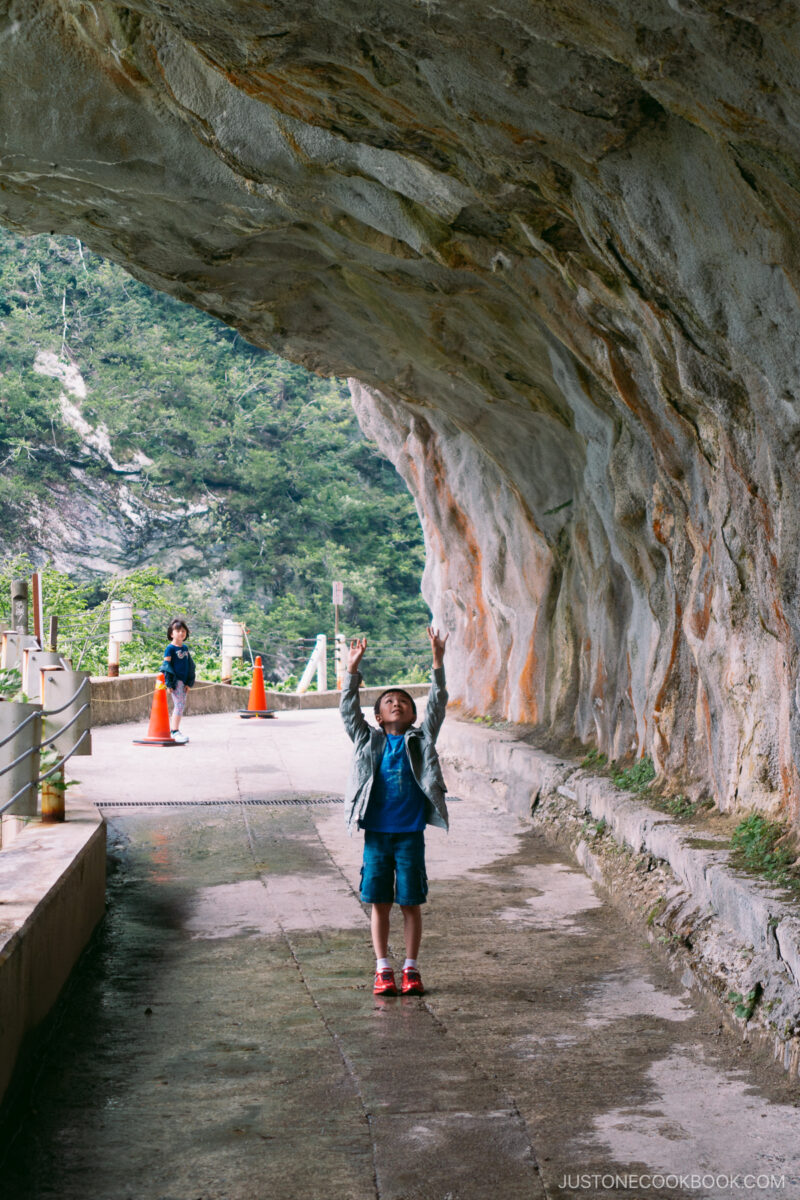
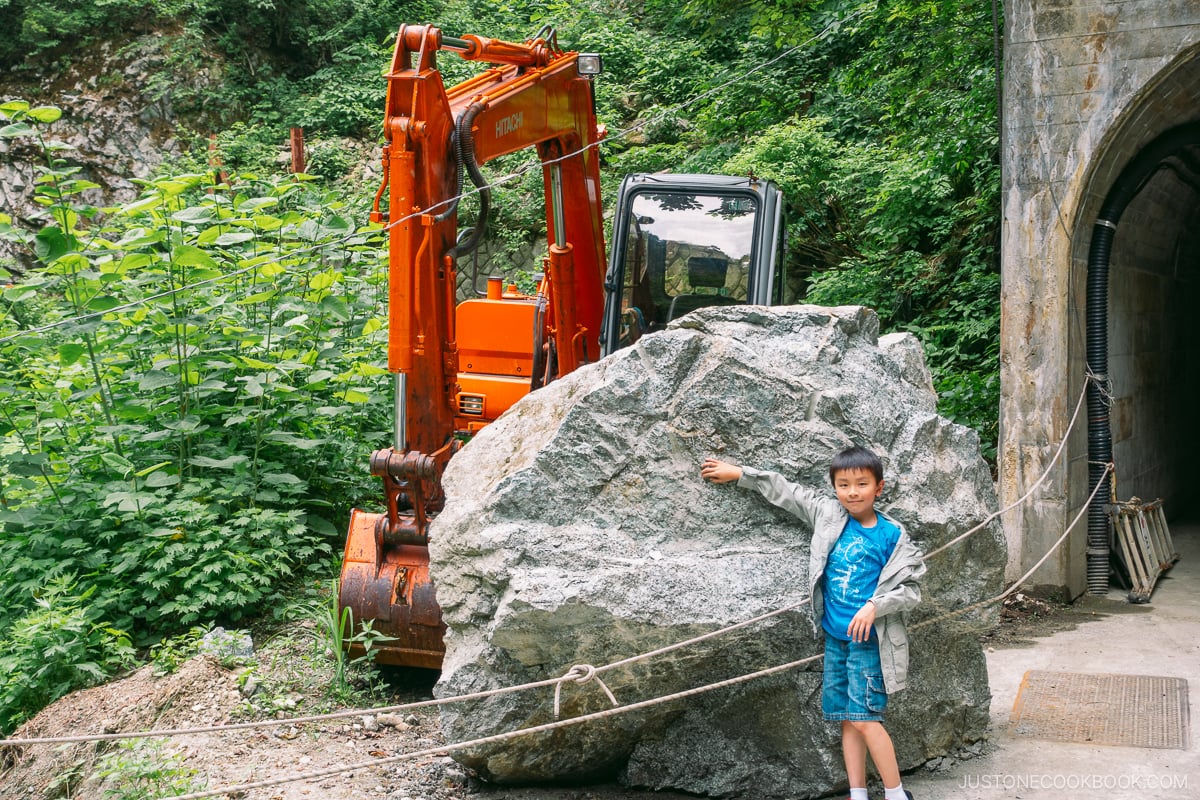
Nevertheless, we were able to explore the viewing platform by the riverside. We crossed the Okukane Bridge (奥鐘橋) to look at Hitokui-iwa (人食い岩), the mouth-shaped rock formation that looks like it’s going to swallow people up. There was a gigantic boulder next to the trail that had just recently fallen.
After we exited the tunnel from Hitokui-iwa, we saw Meiken Onsen (名剣温泉) which accepts overnight guests. Unfortunately, the footbath (足湯) by the Kawara Tenbodai/viewing platform (河原展望台) was also not working for us because landslides had cut off the hot spring.
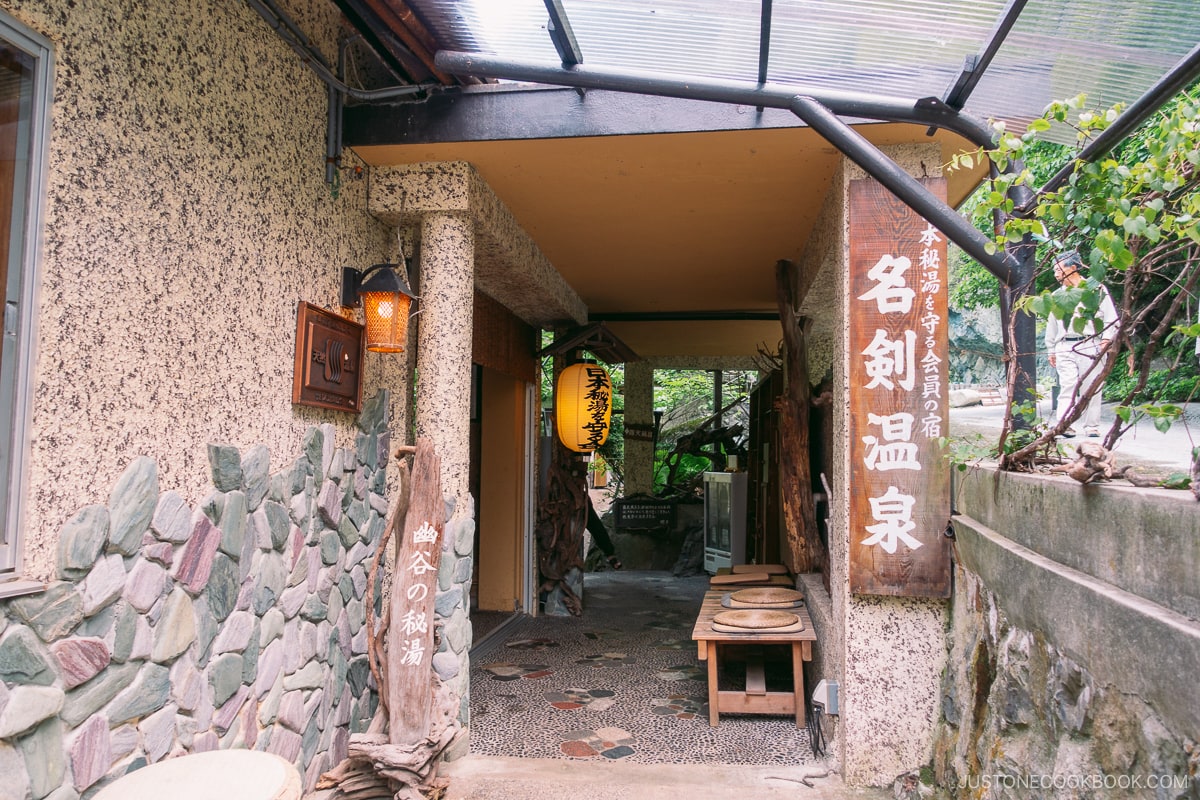
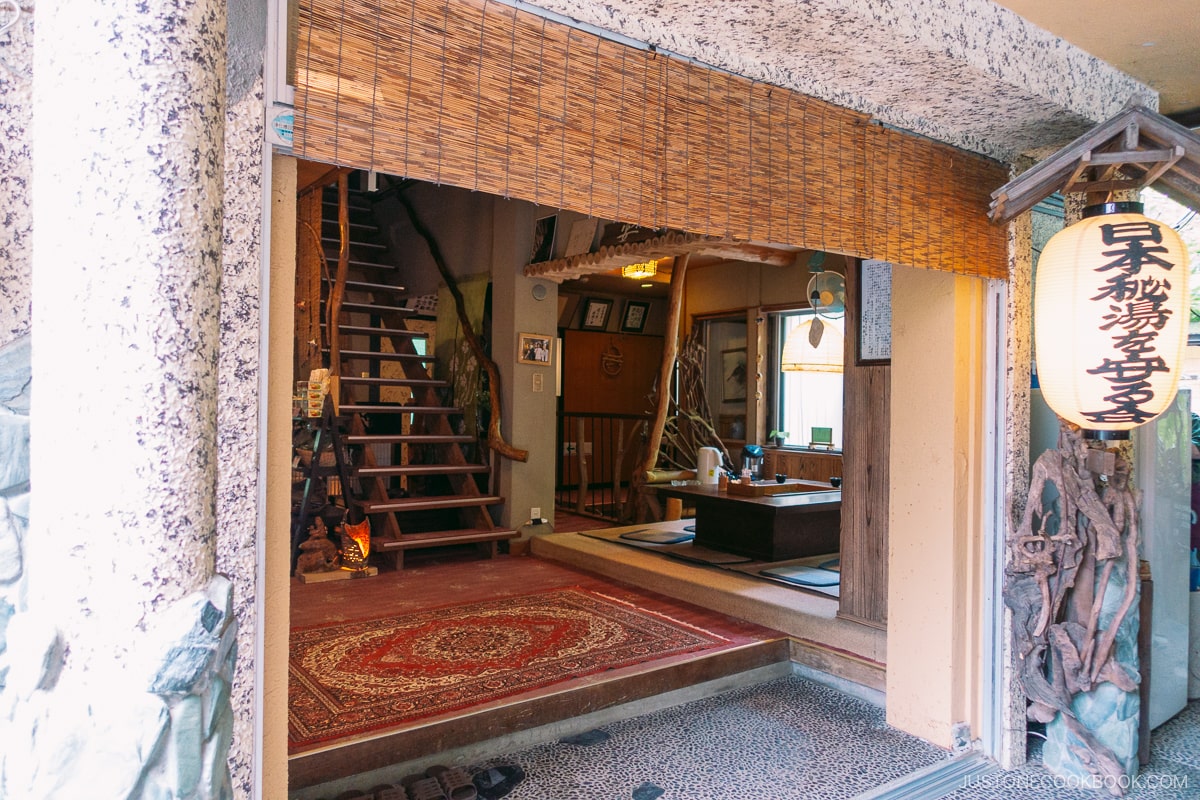
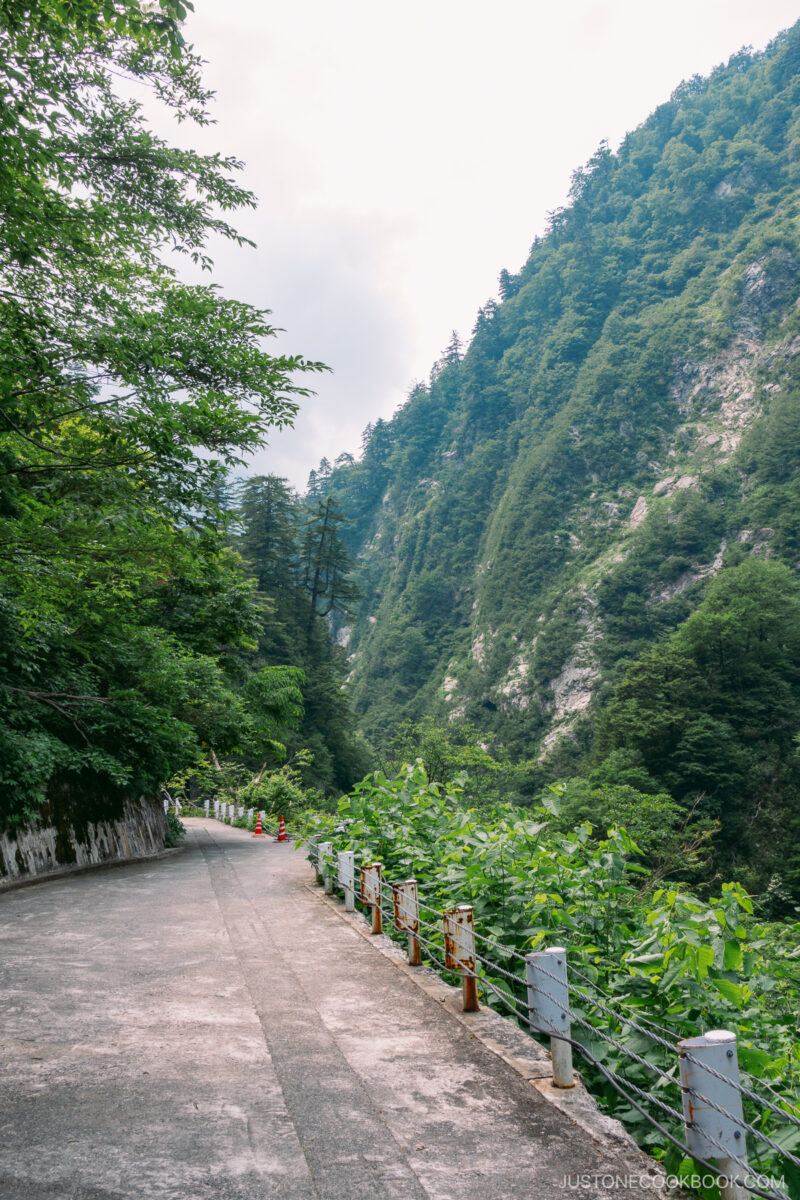
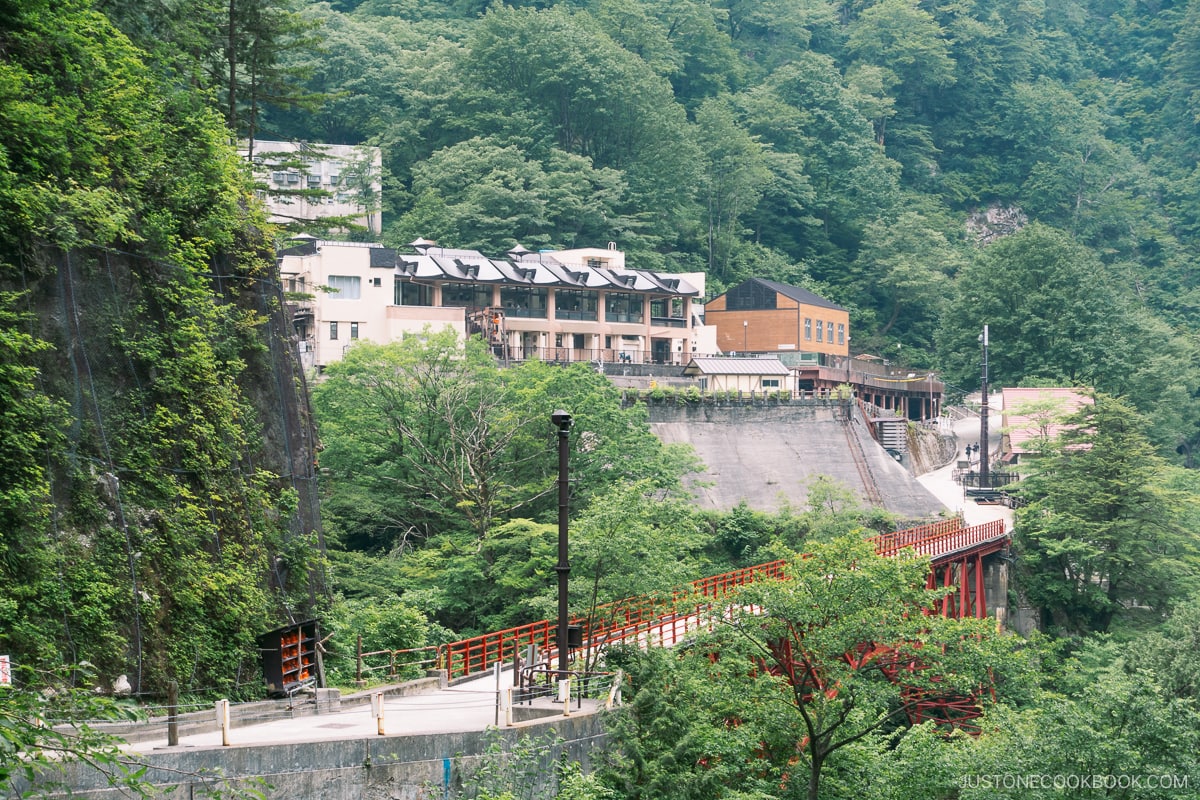
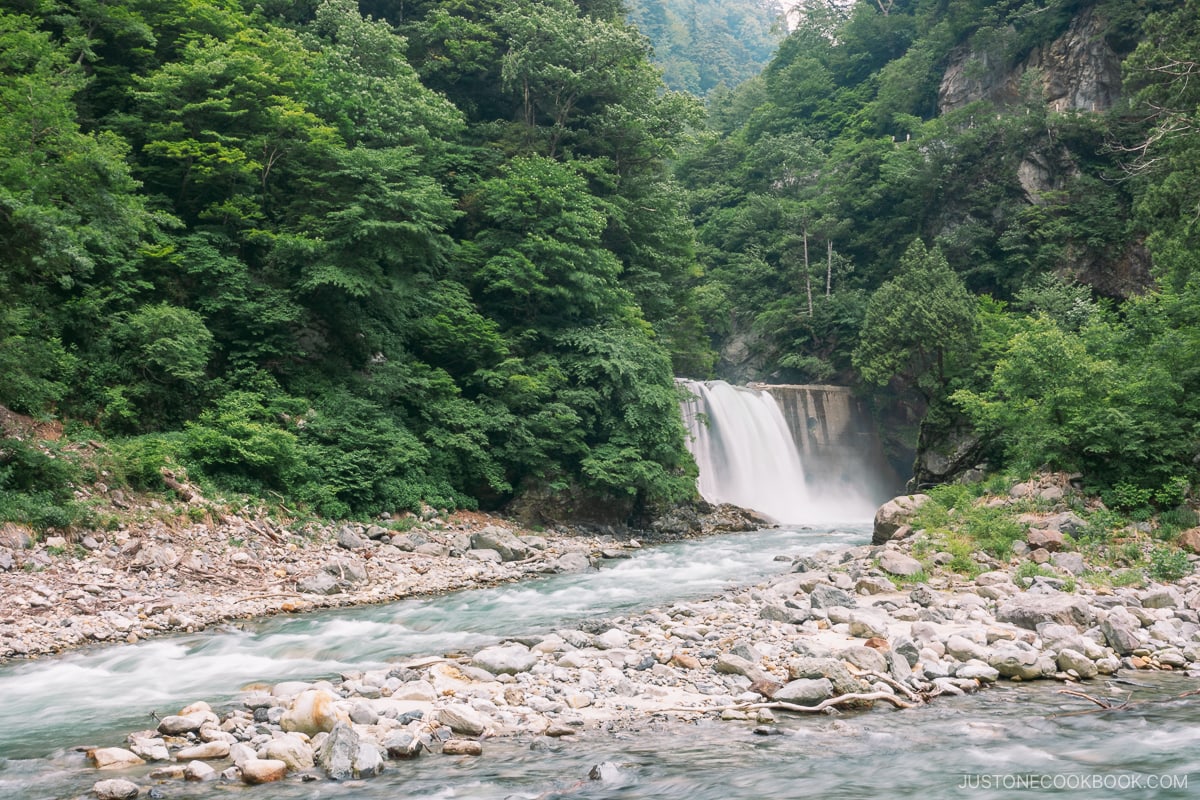
On the hiking trail, one of the workers explained to us that the area is quite dangerous due to the frequent rock slides.
As the sun was setting, we decided to head back to Unazuki station after spending a couple of hours in Keyakidaira. It was a good choice that we upgraded from the open-air car to the enclosed car as it started to rain on the way back.
Japan’s Most Scenic Gorge
Overall, we highly recommend the Kurobe Gorge Torokko Train as a must-visit attraction. Our family had an enjoyable experience immersing ourselves in the stunning gorge scenery, which undergoes captivating transformations with the changing seasons. The nostalgic charm of the rustic trains transports you to a bygone era, adding an extra layer of fun to the journey.
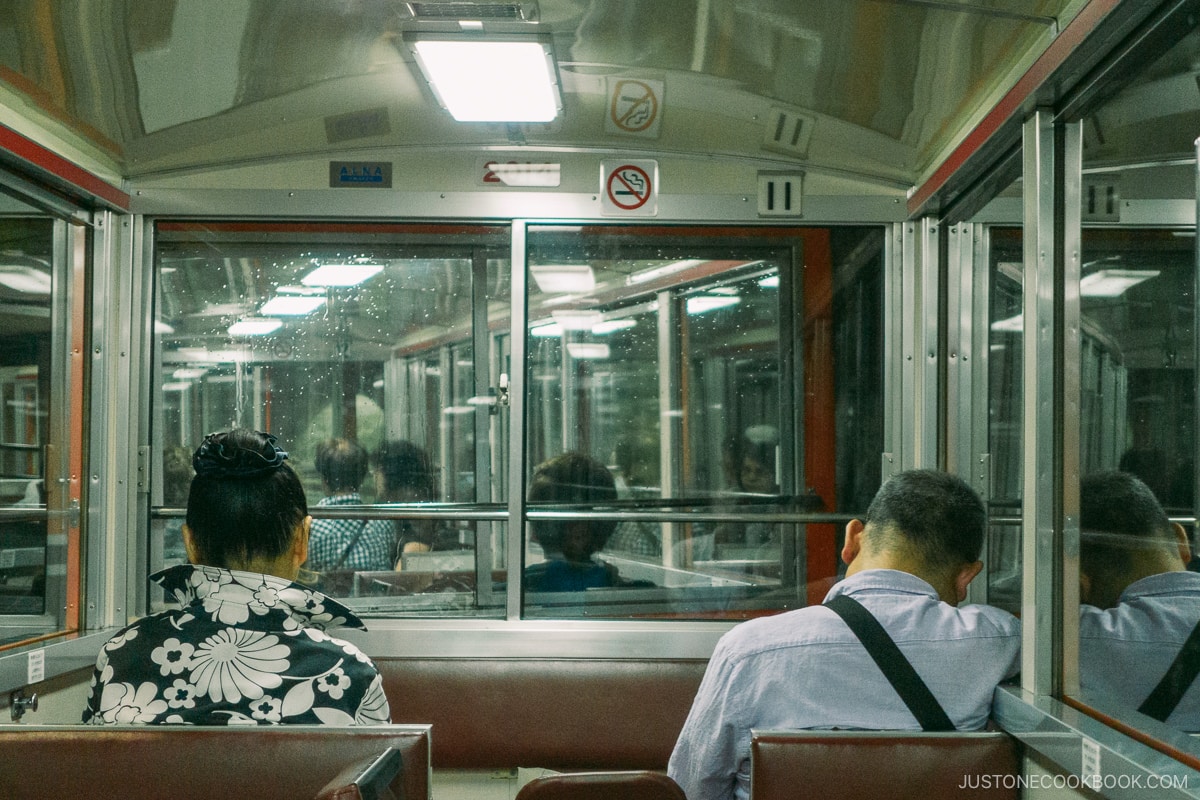
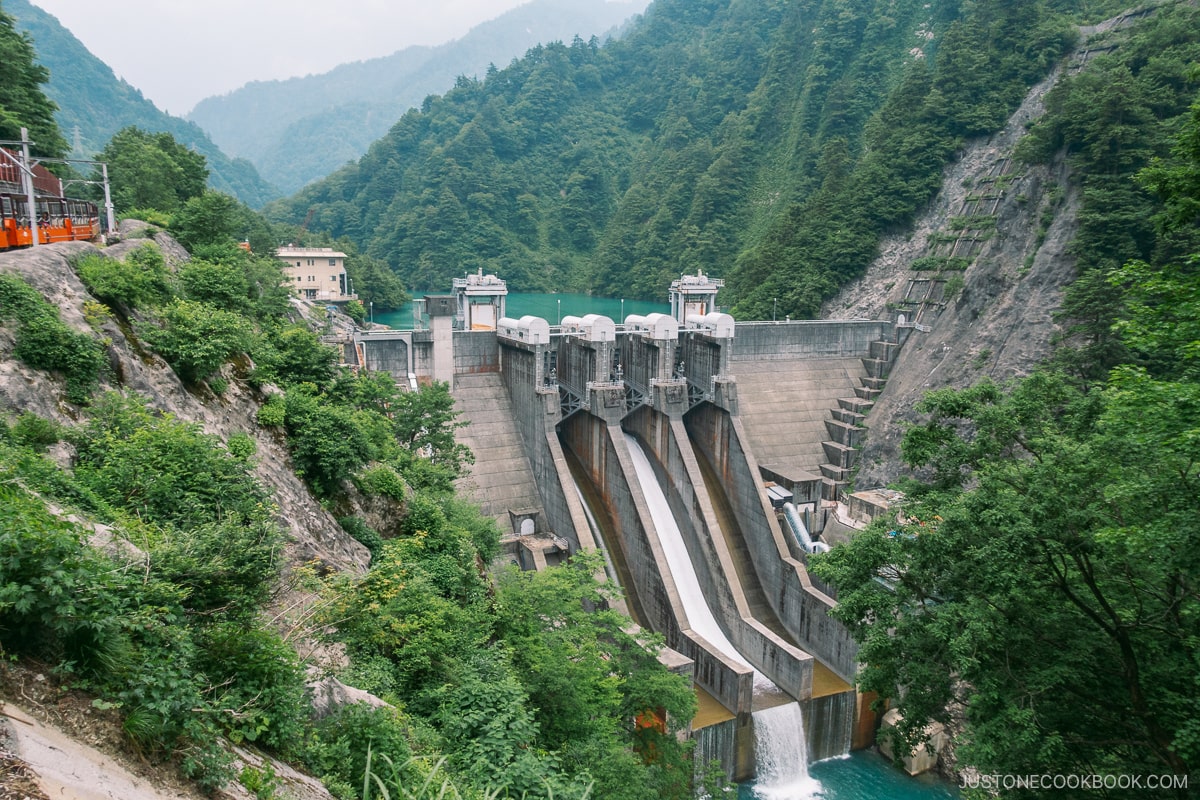
The only thing that I wished to know earlier was the closures of the many sightseeing spots at Keyakidaira. We would have gotten off at Kanetsuri station which saved us the extra travel time and money.
For those planning to visit Kurobe Gorge, we recommend going after mid-October when the leaves start changing and the beautiful red and yellow colors decorate the green forest. If you have any additional questions, here is some info from the Toyama Tourism Association.
Now let’s continue our trip, next stop is Tateyama Kurobe Alpine Route (Snow Corridor)!

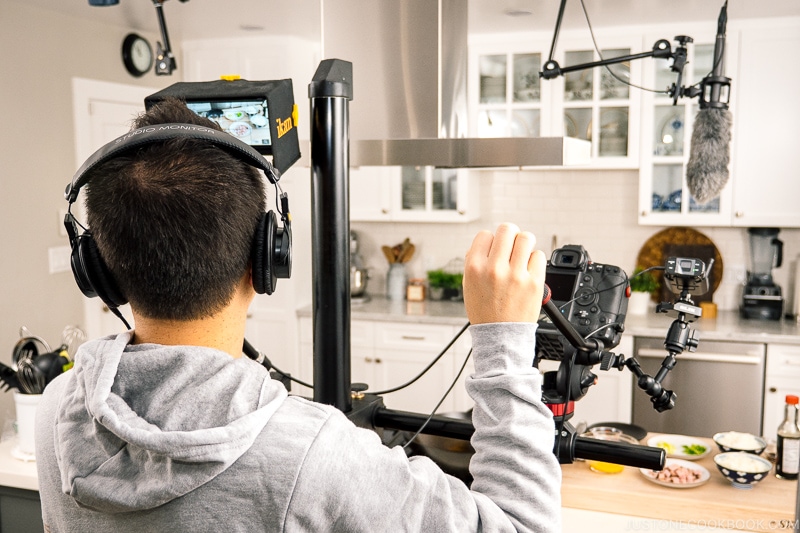









Dear Nami
Love your site on all recipes and know-hows, and your fantastic travel blogs with beautiful images and detailed write-ups on Japan. Gives me inspirations to work on my itinerary for my forthcoming trips.
Best wishes to you & family for Y2016 and years ahead.
Cheers!
Hi Jacqueline! Thank you so much for your kind feedback. I’m so happy to hear that you enjoy my blog. It’s exciting you’re going to Japan! Happy New Year to you as well! 🙂
Fabulous sceneries, train trip and food! I’d love to visit such a dreamlike place.
Cheers,
Rosa
What a wonder trip Nami-san. I love these old fashion trains complete with the “doily lined seats”… LOL… I have never been to Kurobe Gorge but need to get this on my bucket list. Great country side and lovely photos, of course. Have a fun trip!
What a wonderful vacation you’re having. I’m enjoying all your posts and will bookmark them for our next trip to Japan. Thanks and enjoy yourselves, Nami!
This past fall we were in Japan for 4 weeks and among our activities …. other than visiting family in Kyushu….was Kuorbe Gorge. We stayed at Unazuki Onsen hotel The food was fabulous….a multi course Kaiseki meal with a spiney lobster… and the next night a wonderful beef meal dramatically prepared teppanaki style by a chef…..it was a fantastic experience.
This year we are going back for 4 weeks and are planning to stay at Minamisanriku Seaside Hotel……and then traveling further north to Akita Prefecture. I love traveling and visiting the different regions of Japan.
Hi Bond! We thought of staying in a ryokan in Unazuki Onsen, but we ended up not staying there as we had to go to Kurobe Tateyama Alpine Route. It was pretty crazy schedule for us. It would be nice to spend a few days there!! I’ve never been to Akita or any northern part of Japan (besides Hokkaido and Niigata). I hope you have a wonderful trip there. 🙂
I love your travel blog posts, and the hotel and restaurant reviews! The scenic shots are just gorgeous and now I want to ride some trains!
Thanks so much for reading this post, Donna! xoxo
oh look at how fun and how beautiful everything is. What a blessing to be able to do that as a family:) I have missed being by here- I took a few weeks off for summer but I am back now and I am LOVING the new look!
Wow, you have me completely sold on Kurobe Gorge! It looks like so much fun with great views too. The tourism industry should be paying you for these travel posts—they are amazing. 😉 I also had a good laugh at your comment about the grilled gando kama. Can’t wait for your next travel post!
Thank you Kimmi! Haha if tourism notice my blog posts… yeah that sounds good. Maybe I get to travel for free! 😀 😀 😀
Heehee. I just have to apologize to readers who are vegetarians and who are not used to see a fish head on a dinner table (like most Americans). =P
Thank you for always reading my blog posts. xo
Hi Nami I remember I saw somewhere in your website about arranging western people to learn home cooking at Japanese family and advice for traveling in Japan however I can’t find the info anymore. Can you please point me to the related info in your website. Many thanks.
Hi Rita! Yes, I shared it on my email newsletter and Facebook. Please find more info from here:
http://bit.ly/NagomiVisit
I’ve been receiving great reviews from those who have tried this program and I’m truly happy to support their work. 🙂
Hope you enjoy it too!
I feel your pain with your kitchen remodeling. It always takes longer than expected! And is a whole lot messier. 🙁 Anyway, such a fun post! Wish I was there!
Hi John! Yes… it looks like the house won’t be ready before we go back (but I sort of expected it…). It looks like I will have to borrow my friends’ kitchen to shoot new videos. That’s one thing I wanted to avoid… Ahhh! Thank you for reading my post!
I enjoy your travel blogs. I was in Japan a few weeks ago but stayed in the Tokyo area. We are already planning to go back in the Spring! Your blog gives us lots of options when traveling in Japan, thank you !!
Hi Susan! Spring (and fall) is a great time to visit Japan! I hope my travel posts will be helpful. 🙂 Thank you very much for reading my post!
This is fantastic, thanks for sharing! I’m hoping to visit Japan again in a few years, when my little girl is a bit older.
Hi Matt! I’m glad to hear you enjoyed the post. Thank you for reading! It’ll be a lot easier to travel when the kids are older… mainly because we have to use public transportation and we don’t have to carry a stroller or carry the baby with us… 😀 I think our trip got so much easier (and travel more) when my little one turned 6. I remember she still complained about a long walk when she was 5… 😀
Many thanks for your detail and nice travelreport! Realy beautiful countryside, I would like to visit. Greatings from Munich!
Hi Thomas! Thank you for reading the blog post. It’s my pleasure to share our experience from our trips in Japan. 🙂
Many thank Nami for all your sharing – cooking and traveling. I really enjoy watching your cooking video in Facebook. I am very new to your ‘”One Cook Boom” blog, website and blog which I just registered. I am Hong Kong Chinese now live in London. I cook for my Dutch husband every night. Your cooking give me a lot of idea. I have shared your cooking video with my friends in London, Hong Kong and my mother in law in Netherlands – she likes pork belly a lot. My husband and I like Japan a lot. We had three weeks driving holiday in Kyoshu in Oct 2013 before we came to London. We always want to go back. I am really happy to see your blog. Once again many thanks for your sharing.
Hi Rita! Mr. JOC and I are very happy to hear you enjoy our videos! Thank you for watching them and giving us your kind feedback. 🙂 Thanks also for subscribing to my blog and sharing our site with your friends and family. We’re hoping to visit Kyushu either next year or the year after. I’m jealous you could travel there for 3 weeks! 🙂
thanks for sharing the beautiful countryside and tips for traveling…
Hi Elaine! Thank you so much for reading my post! 🙂